

When Do You Need a License To Sail a Catamaran?
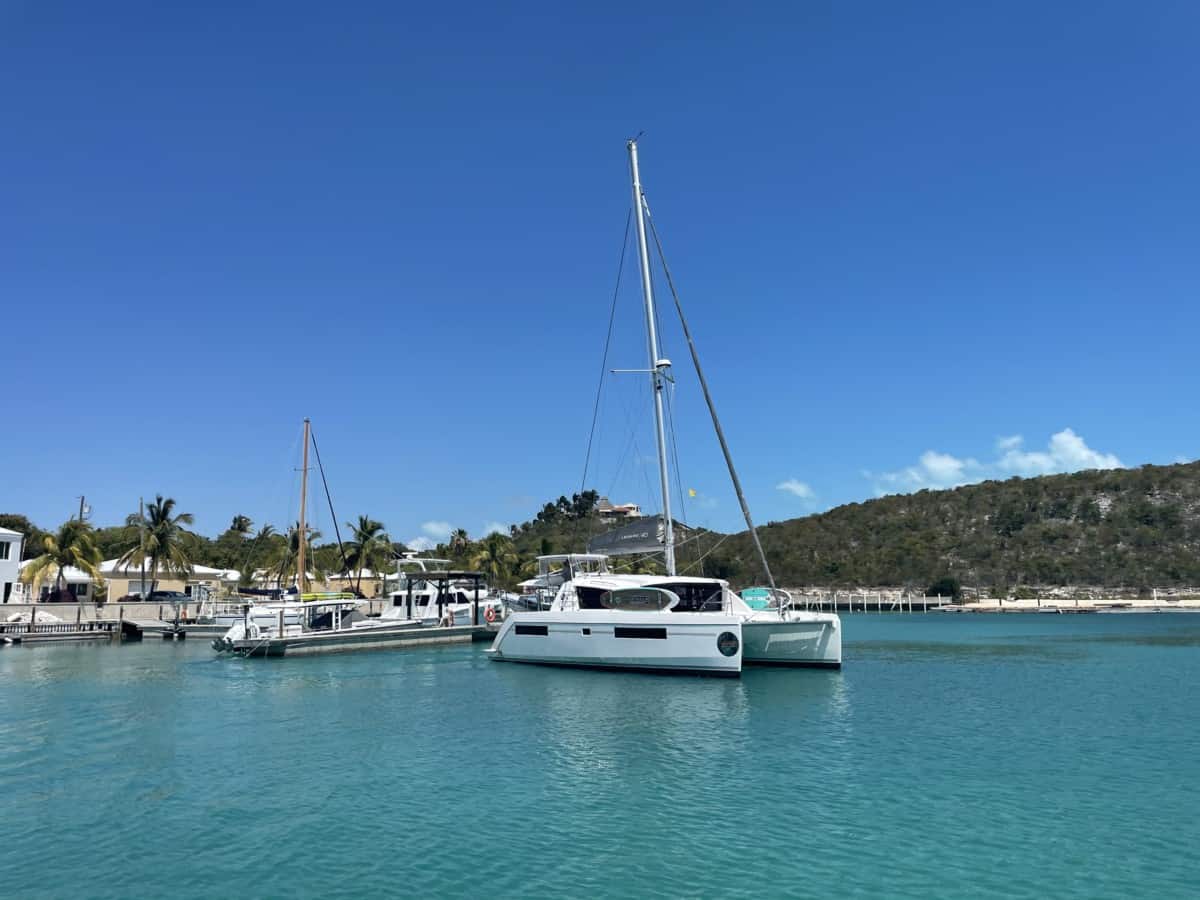
As an Amazon Associate, we earn from qualifying purchases. We may also earn commissions if you purchase products from other retailers after clicking on a link from our site.
When we sailed the Bahamas, none of us had any certification, we all survived and had the time of our lives, but a few years later I have revised my thoughts on getting formal education before sailing bigger oceans.
Sailing a catamaran can be a bit challenging when it comes to figuring out the proper licensing you might have to acquire before leaving port. Different states or countries can have contrasting documentation requirements with regard to sailing, so learning when you’ll need a license to operate a catamaran can make the whole process much more straightforward, especially for less experienced sailors.
You need a license to sail a catamaran in specific states when sailing commercially or sometimes when traveling globally. You will also need a bareboat license for chartering. Otherwise, you don’t need a license to operate a catamaran.
In this article, I’ll take you through an in-depth explanation of the situations that require obtaining a sailing license and those that don’t. I’ll also share what the more experienced sailors have to say regarding this topic.
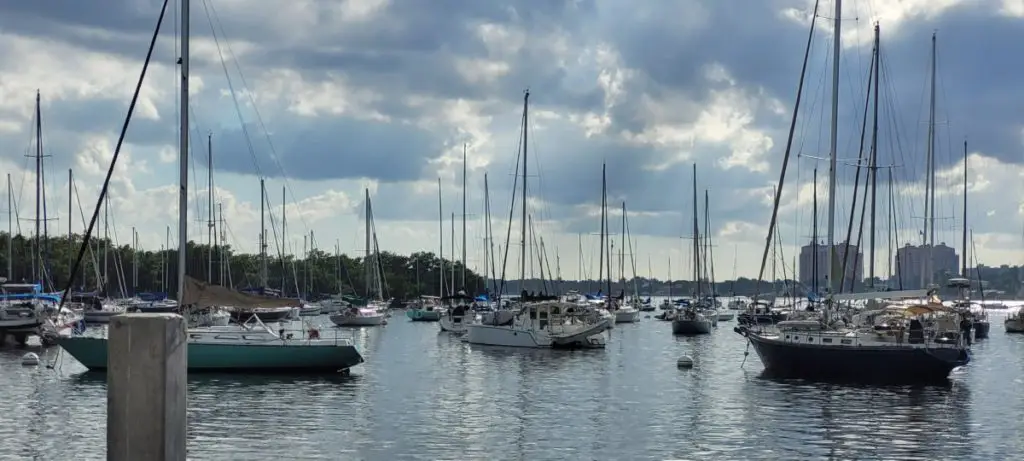
Do You Need a License To Sail a Catamaran?
Whether or not you’re legally required to have a license to sail a catamaran can often depend on many variables, including intent and local or international laws.
You generally do not need a license to sail a catamaran if you’re a recreational sailor. However, if you want to use your sailboat for commercial activities, your local laws require it, or you often travel globally, then you do need to obtain a sailing license.
When it comes to operating a catamaran for recreational activities, chances are you won’t legally be required to obtain a license, which in the US would come from USGC .
Still, this doesn’t mean you can’t seek one out yourself to advance your skills and better familiarize yourself with the practice. Going through a licensing course could help to make you a more capable sailor and remain safer at sea.
While this information will suffice if you don’t plan to take your vessel out of your local borders, regulations can get a little more confusing for those wanting to travel to another state or even internationally. Most of the time, recreational users won’t need a license, even in these cases.
Although you may be visiting a location that, unlike yours, requires licensing to operate a catamaran, these laws usually don’t apply to visitors; therefore, your basic identificational documentation should suffice.
With that said, there can always be some specific states, countries, or waterways that legally require licensing. For this reason, always be sure to research the local laws of the places you’ll be passing through along your trip to avoid any potential legal trouble.
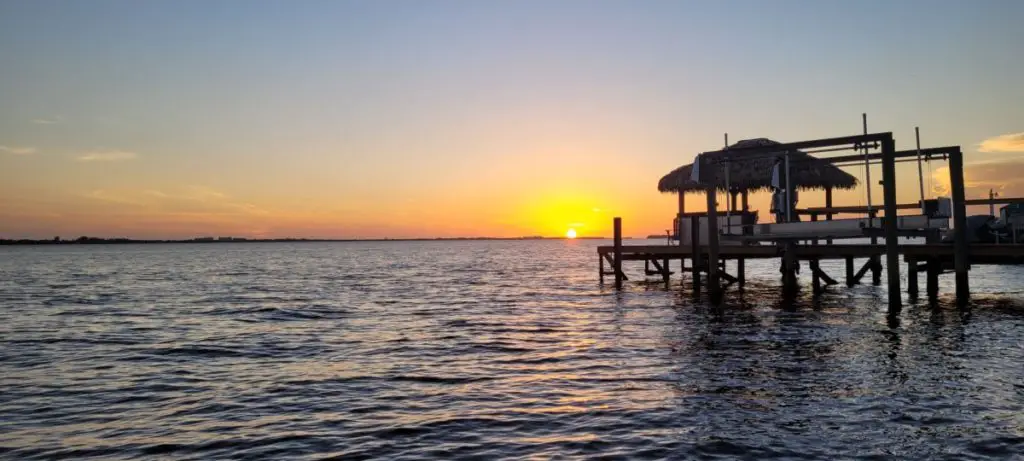
When Do You Need It?
You need a license to sail a catamaran if you use the vessel for commercial purposes, if your local laws require it, or if you tend to travel often globally. The type of license you’ll need to obtain depends on your goals and intentions, as well as the state/country you’re living in.
Firstly, if you’re a commercial sailor, having a sailing license is mandatory. Therefore, before hoisting a sail, seek to obtain a USGC permit, as it is one of the main requirements you need to meet before using the vessel for commercial purposes. I should note that in this case, you’ll also need to be equipped with additional documentation (aside from the USGC license) to use your catamaran legally.
If you’re a recreational sailor, but you often travel globally, you’ll also need to have a license to legally sail the vessel in international waters. Countries and states have different requirements when it comes to documentation, but usually, an ICC or ASA should more than suffice.
Even if sailing laws may sometimes be more forgiving for visitors, you would have to specifically research the regulations of each locality whose waters you’ll be passing through to be entirely sure. Therefore, holding one of these licenses can give you absolute peace of mind and make dealing with logistics much easier.
Having proper documentation can often be necessary even if the specific locality you’re visiting doesn’t require it, as most insurance companies either refuse to insure you without it or give you significantly more expensive rates.
The type of licensing you’ll need to legally sail a catamaran can vary depending on various factors. For most recreational sailors, the OUPV is the most common USCG license. It allows you to operate a vessel carrying up to 100 tons or six passengers .
Here you can find more information on the USGC license that would be the best choice for your specific intentions.
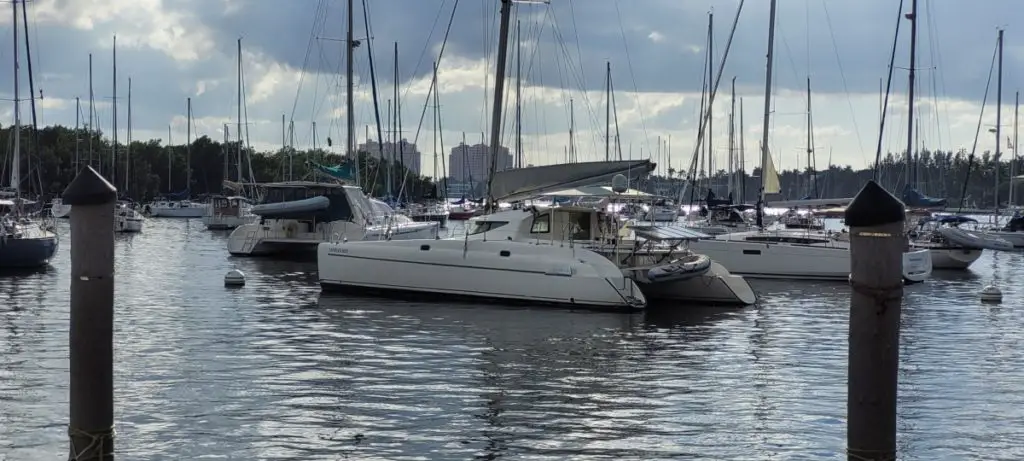
When Do You Not Need a Sailing Certificate?
You don’t need a license to sail a catamaran if you’re a recreational sailor who doesn’t often travel beyond your local borders. So, if your state’s laws don’t require any documentation and you don’t plan on going on many long-distance trips, you won’t need any certification to operate your vessel.
In most states and countries, you’re not legally required to carry a license when sailing a catamaran. Even if you temporarily travel to a location that does, usually short-term visitors aren’t required to be equipped with any form of documentation.
In short, if you’re a beginner boatman, you’re probably well within your rights to operate your catamaran without a license. With that said, obtaining one can help you immensely improve your skills, especially if you want to take on sailing long-term.
When Does a Sailior Think You Need It?
Many sailors think you need a license ( source ) to sail a catamaran even when you’re not legally required if you’re a beginner. They put great importance on being qualified to operate a vessel, even when the law doesn’t require it. The road towards getting a certificate will teach you many skills needed to sail safely.
To get a better hold of the subject and what’s the best option for you, you can look through several forums where experienced sailors and seamen discuss the topic. When doing so, you’ll find out that they see licensing as a tool for inexperienced sailors to get a better understanding of the practice and perfect their abilities, not a formality used only to keep themselves out of legal trouble.
Although most recreational sailors don’t have to have a license to operate a catamaran, there are specific circumstances in which having this piece of documentation is required, so always check your local laws and regulations to decide on what’s the best choice for you.
Here are Some of My Favorite Catamaran Cruising Resources
Thank you for reading this article. I hope you found it helpful as you hopefully start your sailing adventures. Here are some resources that I use as a sailor that I hope you’ll also find helpful. These are affiliate links, so if you do decide to use any of them, I’ll earn a commission. But in all honesty, these are the exact things that I use and recommend to everyone, even my own family. Sailboats: If you’re looking for the best boat to suit your needs, I would recommend a catamaran. If you’re interested, I can show you the differences between catamarans and other types of sailboats .
Books: For getting started, I really like Cruising catamarans made easy . It is actually a textbook from the American sailing association; it is used to get a cruising catamaran certification. There are some other great books, and I have compiled a list of books about cruising catamarans that you will find useful.
Communication: Being out on adventures, whether it be sailing or climbing mountains, good communications are essential to being safe. I recommend two things Google fi (incredibly simple cellular data all over the world) and Garmin inreach mini (for text and voice in remote areas without cell coverage)
Sailing courses: Online sailing courses are great for beginners starting out their sailing career; it’s an efficient way of learning the basics of navigation, throttle controls, and maritime safety. I suggest starting with two free courses from NauticEd .
To see all my most up-to-date recommendations, check out this resource that I made for you!
Owner of CatamaranFreedom.com. A minimalist that has lived in a caravan in Sweden, 35ft Monohull in the Bahamas, and right now in his self-built Van. He just started the next adventure, to circumnavigate the world on a Catamaran!
Leave a Reply Cancel reply
Your email address will not be published. Required fields are marked *
Save my name and email in this browser for the next time I comment.
Recent Posts
Must-Have Boat Gear for Catamaran Sailors!
Sailing is probably the most gear-intensive activity I've ever done; there are so many decisions to be made about what gear to buy now, for tomorrow, and what to definitely never buy. The gear on...
6 Best Trailerable Trimarans For Bluewater and Coastal Sailing
Having a boat costs a lot of money, even when you are not using it, marina fees, etc. And once it is in the water most sailors never go very far from their "home marina" and sailing will be somewhat...

Do You Need a License to Sail a Catamaran? (The Answer Here)

Have you ever dreamed of sailing away on a beautiful catamaran? Whether youre a seasoned sailor or a beginner, its important to understand the legal requirements of sailing a catamaran.
In this article, well explore the need for a license to sail a catamaran , the different types of catamarans, the difference between sailing and power catamarans, and where to get a license.
Get ready to set sail on your own nautical adventure!
Table of Contents
Short Answer
The answer depends on the size of the catamaran and the area you plan to sail it in.
In most countries, you do not need a license or registration to sail a small catamaran , such as a Hobie Cat.
However, if the catamaran is larger than 16 feet or if you plan to sail in a foreign country, you may need to obtain a license or registration.
You should check with your local government or boating organization to find out the specific rules and regulations for the area you plan to sail in.
What is a Catamaran?
A catamaran is a type of boat that is characterized by two parallel hulls of equal size.
It is an ideal choice for sailing due to its stability and spaciousness, and is often used for recreational purposes, such as cruising and fishing.
Catamarans typically have a shallow draft, making them great for navigating shallow waters, and they are often equipped with two outboard motors for increased speed and maneuverability.
The two hulls give catamarans a wider beam than monohulls, which makes them safer and more comfortable in choppy seas.
They also tend to be more fuel-efficient than monohulls and require less maintenance.
Catamarans are becoming increasingly popular as they are easier to operate than monohulls and offer more space and comfort for passengers.
What is a Recreational Boating License?

A recreational boating license is an official document issued by a government agency or marine authority that certifies an individual as legally qualified to operate a recreational boat or sail a catamaran.
This license is specifically designed to ensure that individuals who take to the water for leisure and recreational activities are properly trained and knowledgeable of the laws and regulations pertaining to watercraft operation.
Depending on the country or state, the requirements for recreational boating license may include a nautical knowledge test, a practical boating skills test, and a safety course.
It is important to note that a recreational boating license does not cover the operation of commercial vessels.
In the United States, the U.S.
Coast Guard is responsible for regulating recreational boating.
The Coast Guard requires that individuals who wish to operate a recreational boat or sail a catamaran must be at least 16 years of age and have a valid boating license.
Depending on the state, the license may be referred to as a boating safety certificate or a boater safety card.
The specific requirements for obtaining a recreational boating license may differ from state to state, but generally include a written and practical exam.
The written exam typically covers topics such as navigational rules, local regulations, and safe boating practices.
The practical exam usually involves the demonstration of basic boating safety techniques, such as operating a boat in a safe manner, anchoring and mooring, and using flares.
It is important to note that some states may also require that individuals obtain additional endorsements or certifications for specific activities, such as sailing a catamaran.
Therefore, it is important to check with the local marine authority before operating any watercraft.
What is a Sailing License?
A sailing license is an official document that allows a person to legally operate a sailboat, catamaran, or other type of sailing vessel.
It is generally issued by a government body or sailing organization, and is required in many countries in order to legally sail a boat.
The requirements for a sailing license can vary depending on the country, but typically include passing an exam or course in order to demonstrate knowledge and understanding of sailing safety, regulations, and boat handling.
A sailing license is also often required for larger vessels such as catamarans, as the operating of these vessels requires a higher level of skill and knowledge than smaller sailboats.
Do I Need a License to Sail a Catamaran?

Sailing a catamaran is a popular and rewarding activity that can provide hours of fun and relaxation.
But before you set sail on your catamaran, its important to consider whether or not you need a license.
The answer to this question depends on a variety of factors, including the type of catamaran in question, the size of the boat, and the local regulations.
In general, most countries will require that you have a license to sail any type of catamaran.
This is because sailing a catamaran requires a higher level of skill than sailing a monohull boat.
Depending on the size and type of catamaran, the required license can vary.
For smaller catamarans, a recreational boating license may be sufficient.
For larger catamarans, a sailing license or a powerboat license may be required.
Its important to check the local regulations in your country or state before you take your catamaran out on the water, as the requirements may differ from place to place.
In some areas, you may be required to have a specific type of license, while in others, you may not need a license at all.
Additionally, some countries may have restrictions on the size of catamaran you can sail without a license.
In addition to having a license, you should also be familiar with the local laws and regulations regarding sailing in your area.
These laws may dictate the areas where you can and cannot sail, when you can sail, and the type of vessel you can sail.
Knowing the local regulations can help to ensure a safe and enjoyable sailing experience.
Sailing a catamaran can be an exciting and rewarding experience.
But before you set sail, make sure you understand the local regulations and obtain the appropriate license, if required.
Doing so can help to ensure a safe and enjoyable sailing experience.
What are the Different Types of Catamarans?
Catamarans come in a variety of types and sizes, so its important to understand the differences before you set sail.
A traditional catamaran is a double-hulled boat, typically with two outriggers that create a stable platform.
These vessels are usually designed for recreational use and can range in size from small dingy-style boats to large vessels used for commercial travel and transport.
Larger motor catamarans, such as ferries, often require special licensing as they are typically powered by diesel or gasoline engines. In addition to traditional catamarans, there is a new breed of vessels that are quickly gaining popularity: the trimaran. These boats are similar to catamarans but feature a third hull, or outrigger, that provides extra stability and speed.
When choosing a catamaran, its important to consider the size of the boat and the type of sailing youll be doing.
A smaller boat is suitable for a day trip , while a larger boat may be necessary for longer trips or more challenging conditions.
For those who are just starting out, a smaller boat may be a better option, as it will be easier to handle and requires less maintenance.
The type of sail you choose for your catamaran will also have an effect on the type of license youll need to sail it.
Traditional catamarans are usually equipped with a jib and mainsail, while trimarans typically have a larger mainsail and a smaller jib.
Depending on the size and type of catamaran you choose, you may be required to obtain a license in order to sail it legally.
No matter what type of catamaran you choose, its important to make sure you are familiar with the local regulations in your area.
Make sure you understand the size and type of boat you need to have a license for, as well as any special regulations that may be in place for sailing in your area.
With the right information and preparation, you can safely and legally enjoy the thrill of sailing a catamaran.
What is the Difference Between Sailing and Power Catamarans?

When it comes to sailing a catamaran, it is important to understand the difference between sailing and power catamarans.
Sailing catamarans are designed for sailing and require skill and knowledge in order to operate.
The hulls are usually made of lightweight materials such as fiberglass or aluminum and are designed to be sailed rather than powered.
They are also equipped with sails and rigging, and require the sailor to be knowledgeable about wind and sailing techniques.
On the other hand, a power catamaran is designed for motorized propulsion and requires a less sophisticated level of knowledge.
The hulls are typically made of heavier materials such as steel or fiberglass and are designed to be powered by an engine.
They are also equipped with propellers and a rudder, and require the sailor to understand the basics of navigation and operating a motor.
The difference between sailing and power catamarans is important to consider when deciding whether or not you need a license.
If you plan to sail a catamaran, you will need to be knowledgeable about sailing and have a valid sailing license in order to legally operate your vessel.
However, if you plan to operate a power catamaran, you may be able to get away with having only a recreational boating license.
It is important to check the local regulations in your country or state before you take your catamaran out on the water, as the requirements may differ from place to place.
Where Can I Get a License to Sail a Catamaran?
If you want to take your catamaran out on the water, you need to make sure you have the right license.
Depending on the size, type, and where you plan to sail your boat, you may need a recreational boating license or a sailing license.
Generally, a sailing license is required to sail a catamaran of any size, but it is important to check the local regulations in your country or state for the specific requirements.
In the US, the Coast Guard requires that anyone operating a vessel over 16 feet in length must have a valid license.
For catamarans, this is usually referred to as a Sailing Endorsement, which is a special license that allows you to operate a catamaran.
To obtain this license, you must first take a boating safety course and pass a written test.
In the UK, the Royal Yachting Association (RYA) offers a series of courses and exams to obtain a sailing license for catamarans.
The courses range from basic courses such as Navigation and Seamanship to more advanced courses such as Catamaran Racing and Offshore Cruising.
The cost of the courses and exams varies depending on the level of the course, but typically range from 50-150.
In Australia, the Australian Maritime Safety Authority (AMSA) offers a range of courses to obtain a license to sail a catamaran.
The courses include Basic Seamanship, Advanced Navigation, and Catamaran Racing.
The cost of the courses and exams varies depending on the level of the course, but typically range from $50-$200.
In addition to obtaining a license, it is also important to ensure that your catamaran is properly registered and insured.
This can usually be done through your local marina or boat club.
It is also important to check the local regulations in your country or state for any other requirements that may be needed before you take your catamaran out on the water.
Getting a license to sail a catamaran can seem like a daunting process, but it is important to ensure that you are properly prepared and trained before taking your boat out on the water.
By taking the time to get the right license and following the local regulations, you can ensure that you and your passengers are safe on the water.
Final Thoughts
In conclusion, sailing a catamaran requires more skill than sailing a monohull boat, so a license is usually required.
Depending on the size and type of catamaran, the required license can vary and may differ from place to place.
It is important to check local regulations before taking your catamaran out on the water.
If you need a license to sail a catamaran, you can get one from your local boating authority or sailing school.
Now that you know the answer to the question, “Do you need a license to sail a catamaran?” you can safely and confidently set sail on your next adventure!
James Frami
At the age of 15, he and four other friends from his neighborhood constructed their first boat. He has been sailing for almost 30 years and has a wealth of knowledge that he wants to share with others.
Recent Posts
When Was Banana Boat Song Released? (HISTORICAL INSIGHTS)
The "Banana Boat Song" was released in 1956 by Harry Belafonte. This calypso-style song, also known as "Day-O," became a huge hit and remains popular to this day for its catchy tune and upbeat...
How to Make Banana Boat Smoothie King? (DELICIOUS RECIPE REVEALED)
To make a Banana Boat Smoothie King smoothie at home, start by gathering the ingredients: a ripe banana, peanut butter, chocolate protein powder, almond milk, and ice. Blend the banana, a scoop of...

- All Blog Posts
- Sailing Education Posts
- Boating Knowledge
- Free Sailor Toolkit
- Sailing Vacations Posts
- Yacht Charter Guides
- Join a Sailing Flotilla
- Sailing Adventure
- FREE Virtual Reality Sailing Training & Racing
- 2 Free Courses >
- Online Courses
- Vacations & Charters
- Schools & Instructors
- International Sailing License
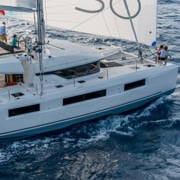
Catamaran Qualification and Training
How do I Switch to Skippering a Catamaran?
We get this call almost every day – “ I’ve been sailing a monohull for years and am confident. I want to take a catamaran on a sailing vacation. What does it take to switch to a catamaran? Do I need a Catamaran Certification?”
Looking at switching over to sailing a catamaran on a sailing vacation or to buy? The thought of it can be intimidating and everyone wants to sell you something which may or may not be correct information.
Here we break it down for you to the real story and take away the intimidation.
First off, Yacht Charter Companies are totally fine to upgrade you to a catamaran as long as you have had plenty of large monohull skippering experience. “Plenty” meaning more than say 50 days of skippering a large monohull. “Large” meaning 38 ft (12m). If you’ve done that, you are essentially good to go – except that you’ll need to demonstrate your stated skills to the charter base once you get there. They will want to take you out for about 3-4 hours and make sure you are comfortable maneuvering the boat in the marina and getting the sails up and down.

Much of your experience should be fairly recent i.e. within the past 5 years and some in the last year or so. You should not be “rusty”. Also, you don’t want to exaggerate your previous experience because if the charter company feels that you are not so competent to handle their million-dollar boat, they will deny you being able to take it by yourself and demand that you take a Captain for either a few extra days or the whole week. A captain takes up a cabin so some of your guests will either need to sleep on the trampoline, in the sail bag, in the forepeak if there is one, on the couch, or under the table. In this sense just check in with yourself – have you really had that amount of experience and do you feel confident that you can pick up the maneuvering bit in a few hours enough to impress the charter company at the base? If so – go for it.
Regarding operating a catamaran, for now, we recommend that you at least take the NauticEd online Catamaran Sailing Confidence Course . This will give you a good idea of what to expect in terms of upgrading. The course is aptly named – it is designed to give you the confidence that operating a Catamaran is really pretty simple. It assumes that you know how to sail a monohull.
There are some big differences in operating a catamaran sailing yacht over a monohull. Fortunately most work in your favor. Maneuvering for example is a breeze (excuse the pun). A catamaran can spin inside its own length. The dual engines make maneuvering incredibly simple. BUT you just have to get used to it – i.e. gain a bit of experience. So how do you gain experience when no one will rent you a Catamaran?
Having said all the above, we apply the word PRUDENCE. Prudence means you think about your abilities, your true experience, your true knowledge, and how you handle yourself in an emergency situation. You ask yourself, what would a prudent person do in my situation? Many times the true answer would be to get some professional instruction prior to the trip just to be sure. A professional catamaran instructor will run you through everything you need to know when switching over to a catamaran. They will take the time you need to master your abilities.
NauticEd has many professional catamaran instructors and some can travel with you to that perfect destination. Visit our sailing schools page and look for the CAT logo next to each school.
What if I Don’t Have a Lot of Monohull Experience?
See prudence above. It also means that it is doubtful that any yacht charter company will give you the Catamaran for a week – nor should they. You don’t have enough experience. Even if you go through a “zero to hero” program at a school, and get a “catamaran certificate” you still don’t have enough experience. A catamaran certificate DOES NOT GUARANTEE you to be able to rent a catamaran – a full resume does.
Here is a pertinent blog article we wrote on why hire a captain on a sailing vacation. Read that article before you think about “winging” it.
What we totally recommend to solve this chicken-before-the-egg problem is to simply hire a local skipper on your Catamaran Sailing Vacation – the cost will be around $1500 for the week and you will learn so much more because you are actually there and actually doing it. The Captain will teach you how to handle the boat and by the end of the week, you will be able to add that experience to your logbook and resume – getting you closer to going on your own. There are so many other advantages to hiring a skipper – see the article above.
Sailing in the Mediterranean
If you’re ever planning on going to the Mediterranean (you should), you’ll need to master the Mediterranean Mooring technique. The Med Mooring is when you perfectly back your boat to the (very hard concrete) cay (pronounced key), stop perfectly within 2 ft (0.75m) of your stern to the cay, and your crew perfectly attaches docklines in the right manner to the cay, then pick up a slimey line running from the cay to a Corpa Morto (concrete block out in the slip channel) and perfectly attach that to both bows. In reality it is easy and we explain it very well in the Catamaran Sailing Confidence course. But you need some experience at doing that. To gain the Mediterranean Sailing License – the SLC, you need to demonstrate your skills, knowledge, and experience to your assessor as a requirement for gaining the SLC license.
In the Mediterranean, you will not do a Mediterranean Mooring once or twice during a weeklong vacation, you’ll do it maybe 10 times and each time you have to do it perfectly because there is likely to be a 10M Arab Prince’s yacht right next to you.
It is thus a very good idea to become a master at Mediterranean Mooring before you go sailing in the Mediterranean skippering your own boat. Don’t worry we gotcha covered. Catamarans are more maneuverable. All our SLC Assessor/Instructors are Mediterranean Mooring qualified.
Sailing License and Certification
You don’t need a license or certification to sail a large Catamaran in the Caribbean or Pacific. Companies that tell you so are just trying to sell you something. If they just told the truth, you could believe other things that they say but as soon as they say you need a catamaran certification, drop and run away. What you do need is to be confident and competent – if they start there then you should continue conversations.
For the Mediterranean and the Seychelles you need a Sailing License. A sailing license is similar in nature to a car drivers license. It is a legal requirement. The difference is that Countries and States are not set up to do competence assessments on boats themselves. Thus they appoint officially recognized sailing education bodies such as NauticEd to oversee the issuance of licenses. NauticEd issues the SLC which is an officially recognized sailing license for the Mediterranean and Seychelles by those governments and port authorities. Yacht Charter companies themselves are responsible for ensuring that their clients show a sailing license upon arrival at the base (or beforehand). They take the license to the local port who gives them permission based on the license for the yacht to leave port with the licensed skipper.
Acceptable licenses for the Mediterranean are the NauticEd SLC and the United Nations ICC (issued by European companies). The IPC has been known to work although in some cases it has been denied because of its rubber-stamp nature. Some IPC’s are issued by passing a 1 week long zero-to-hero course (only) and the holder shows up to the base with a license but no competence. We don’t knock “zero-to-hero” courses since all education is good education (well mostly). Just that yacht charter companies have thus been burned. You must be competent plus hold a license to charter a yacht. Standards for the ICC and the SLC have been put in place to ensure competence before licensure.

NauticEd provides a Catamaran Sailing Certification in two forms. One is a Catamaran Qualification, the other is a Catamaran Endorsement. The difference is that a Catamaran Qualification means a student has passed the online catamaran course and has demonstrated via their logbook sufficient catamaran sailing experience for NauticEd to feel confident that the charter company will allow the client to properly and safely charter their catamaran vessel. The Catamaran Endorsement means that the student has demonstrated their on-the-water catamaran skills to a NauticEd Professional Assessor and that the Assessor felt comfortable that the student was competent. The Endorsement carries more weight than the Qualification. Here is our support article on Catamaran Qualification and Endorsement .
We hope that gave you some good thoughts about upgrading to a catamaran.
The takeaways are:
- a short day of training and competence gaining
- OR find a training instructor for a weeklong Catamaran sailing adventure.
If you’re thinking about taking a sailing vacation, the NauticEd Sailing Vacations team can help with the entire booking reservation process. We don’t charge a fee and often save our clients money by our large database search ability.

My vision for NauticEd is to provide the highest quality sailing and boating education available - and deliver competence wherever sailors live and go.
You might also like
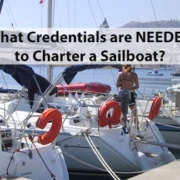
TWEET ABOUT

FIGHT CHILDHOOD CANCER
NauticEd is a fully recognized education and certification platform for sailing students combining online and on-the-water real instruction ( and now VR ). NauticEd offers +24 online courses , a free sailor's toolkit that includes 2 free courses, and six ranks of certification – all integrated into NauticEd’s proprietary platform. The USCG and NASBLA recognize NauticEd as having met the established American National Standards. Learn more at www.nauticed.org .

The NauticEd Vacations team are Expert Global Yacht Charter Agents – when you book a sailing vacation or bareboat charter through NauticEd, we don’t charge you a fee – we often save you money since we can compare prices from all yacht charter companies. PLUS, we can give you advice on which destination or charter company will suit your needs best. Inquire about a Sailing Vacation or Charter .
Online Sailing Courses Sailing Vacations | Charters Practical Sailing Courses Sailing Certification | License
Sign up for 2 FREE Sailing Courses Try sailing in Virtual Reality! Gift a Friend a Sailing Course Sailing Events | Opportunities
About NauticEd Contact Us NauticEd Support Privacy Policy
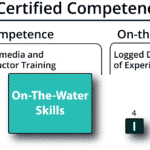

Do I Need A License To Sail A Boat?

Do I Need a License to Sail a Boat?
Many scenic water bodies are offering recreational enjoyment all across the United States. But before heading out on the water, it’s of great importance that you’re familiar with sailing laws and license requirements, have sailing education, and adhere to safe sailing procedures.
Do I need a license to sail a boat? This is perhaps one of the first questions you should ask yourself before venturing out on the water to sail a boat. You certainly do not want to find yourself on the wrong side of the law. Simply put, sailing a boat is as strict in terms of test competency as it is when it comes to a car license. This is because there are varying laws and registration requirements depending on each state. In other words, some states require you to obtain a license to sail a boat.
Unlike places like the UK and Australia, the United States does not have a clear-cut law on whether you need a license to sail a boat. In other words, it’s mandatory in some states that you must have a license to sail a boat whilst it’s not mandatory in other states. As such, you should know the legal requirements of the state that you’re planning to sail your boat before venturing out on the water.
In this brief guide, let’s take a look at various legal requirements while highlighting where you must or must not have a license to sail a boat.
Table of contents
State by State Legal Requirements
At the moment, there are only eight states that do not require you to have a license to sail a boat within their waterways. They include:
- South Dakota
All the remaining states have individual laws and licensing requirements that can differ from state to state. It’s important to note that a handful of these states will require you to obtain an official sailing license. However, most of them will require you to complete a mandatory safety course to be allowed to sail a boat.
Here’s a law map of the states that require a license to sail a boat and those that don’t.

The United States Coast Guard Captain’s License (USCG)
When it comes to recreational sailing, the USCG isn’t a legal requirement. It, however, remains one of the most popular qualifications for the sailor looking to advance their sailing skills, especially in terms of maritime rules and regulations. For commercial sailors, the USCG is of great importance given that it is one of the requirements when it comes to the strict rules regarding carrying passengers.
OUPV Commercial License
The most common type of license under the USCG is the Operator of Uninspected Passenger Vessel (OUPV). With this license, you can operate a vessel weighing up to 100 tons or a vessel carrying up to six passengers. This is essentially why this license is also popularly referred to as a 6-Pack license. With this license, you can operate recreational vessels that are usually used in scuba diving, tour cruises, and charter fishing.
To get this license, you’ll be required to log 360 days on the water since your 16th birthday. A day in water generally means that you have to spend at least 4 hours on the water while spending 12 hours on the water can be logged as 1.5 days. In essence, the OUPV is meant to test your seamanship knowledge, navigation skills, and understanding of rules and regulations. These are minimum requirements that must be tested formally before you can be officially referred to as “Captain”. It’s surely not an easy task but quite manageable if you put in the hours and pay close attention.
You should, however, keep in mind that the OUPV captain’s license is not legally required for recreational boaters, especially if you do not have any intention of operating a commercial vessel now or in the future. In most cases, the boating licenses set by states are generally meant to brush up on safety and navigational skills. But it’s still nice to go for the OUPV license, especially if you like the pride that comes when you achieve such a distinguished designation.
Master Captain’s License
The USCG Master’s License is the highest level of license that you can acquire as far as sailing is concerned. It allows you to operate vessels in increments of up to 100 tons. This will largely depend on your boating experience and the number of hours logged. It’s important to note that you do not have to obtain an OUPV captain’s license as a requirement to get a Master Captain’s License. In other words, you can skip the OUPV captain’s license and go straight to the Master Captain’s License.
This license allows you to perform the operational duties of an OUPV license. It also allows you to operate Inspected Passenger Vessels that are officially approved to have seven or more passengers aboard. But to be eligible to operate a vessel that can carry seven or more passengers, you must also have a USCG Auxiliary Sailing Endorsement. You should also get the Assistance Towing Endorsements if you want to commercially assist ground vessels at a fee.
Sailboat Captain’s License
You should always remember that the USCG is very different from the US Sailing Association and the American Sailing Association. While the USCG provides sailing license, the USSA and the ASA provide sailing certification programs. In other words, the USCG gives you the license to operate a boat while the USSA and ASA teach you how to sail a boat .
In essence, it’s important to go for the USSA and ASA if you want to learn how to operate a vessel but choose the USCG if you want a license to operate a vessel. So whether you want to be the captain of a fishing boat as a guide or a passenger’s vessel, you’ll need a USCG license. To this end, it’s quite clear that recreational sailing in the United States is regulated in different ways depending on the state, the size of the vessel, and the number of passengers it is approved to carry. It’s important to check out whether or not you require a sailing license to operate a vessel in your state before venturing out on the water.
Related Articles
Daniel Wade
I've personally had thousands of questions about sailing and sailboats over the years. As I learn and experience sailing, and the community, I share the answers that work and make sense to me, here on Life of Sailing.
by this author
Licensing and Courses
Most Recent

What Does "Sailing By The Lee" Mean?
October 3, 2023

The Best Sailing Schools And Programs: Reviews & Ratings
September 26, 2023
Important Legal Info
Lifeofsailing.com is a participant in the Amazon Services LLC Associates Program, an affiliate advertising program designed to provide a means for sites to earn advertising fees by advertising and linking to Amazon. This site also participates in other affiliate programs and is compensated for referring traffic and business to these companies.
Similar Posts

How To Choose The Right Sailing Instructor
August 16, 2023

Cost To Sail Around The World
May 16, 2023

Small Sailboat Sizes: A Complete Guide
October 30, 2022
Popular Posts

Best Liveaboard Catamaran Sailboats
December 28, 2023

Can a Novice Sail Around the World?
Elizabeth O'Malley
June 15, 2022

4 Best Electric Outboard Motors

How Long Did It Take The Vikings To Sail To England?

10 Best Sailboat Brands (And Why)
December 20, 2023

7 Best Places To Liveaboard A Sailboat
Get the best sailing content.
Top Rated Posts
© 2024 Life of Sailing Email: [email protected] Address: 11816 Inwood Rd #3024 Dallas, TX 75244 Disclaimer Privacy Policy

- Mariners Learning System - User Guide
- Online Learning
- Online Testing
- Captain's Licenses
- FCC Licenses
- Student Account (Course Locker)
- Other Helpful Articles
- Course Locker Login
- General Questions
- General Requirements
- OUPV/Six-Pack
- 25/50 or 100 Ton Masters
- OUPV/Six-Pack Upgrade to 25/50 or 100 Ton Masters
- Assistance Towing Endorsement
- Auxiliary Sailing Endorsement
- Deck License Renewal
- Captain's Licenses - Application
- Overview on FCC Licenses
- Types of FCC Licenses
- FCC Licenses - Application
- Contact Information
- Help Center
- Captain's Licenses - General
Captain’s Licenses: Deciding Which License is Best for Me
Understanding the basics of a captain's license.
What are the types of captain’s licenses?
The two main captain’s licenses issued by the Coast Guard are the Operator of Uninspected Passenger Vessels, also known as the Six-Pack or charter boat captain’s license, and the 25, 50, or 100-Ton Master License.
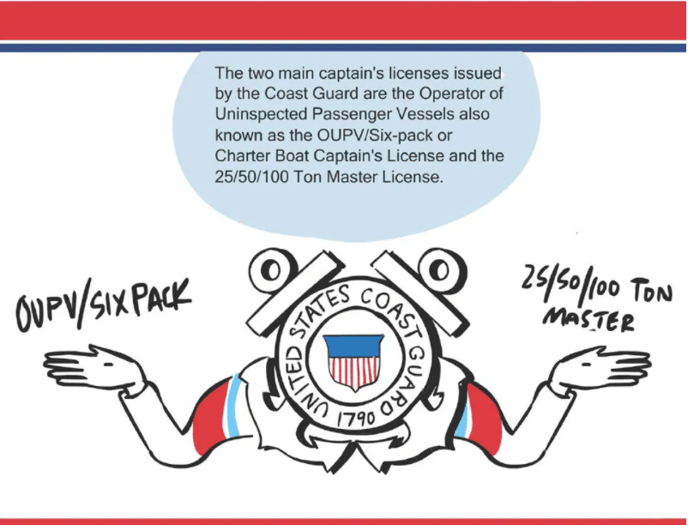
The Six-Pack Captain’s License allows the holder to carry up to six paying passengers plus crew on uninspected vessels up to 100 gross tons, hence the term six-pack. These are usually recreational vessels that are normally engaged in charter fishing, scuba diving, or tour cruises.
The 25/50 or 100 Ton Master Captain’s License allows the holder to operate inspected vessels as well as uninspected vessels. Any vessel that is authorized to carry more than six paying passengers must have on board a captain who holds a Master's license. Ferry boats, harbor tour boats, whale watching, and water taxis are examples of inspected vessels.
What endorsements can I add to my captain’s license?
Two additional endorsements can be added to your license. The Towing Endorsement may be issued to those who hold a Six-Pack or Master license and would like to engage in assisting vessels for a fee. To commercially assist other vessels that may be aground, disabled, out of fuel, or experiencing some other malfunction requires an endorsement for commercial assistance towing.

Licensed Masters or mates may also be endorsed for sail or auxiliary sail as appropriate. This endorsement authorizes the holder to operate inspected sale or auxiliary sailing vessels within the scope and limitations of their license.
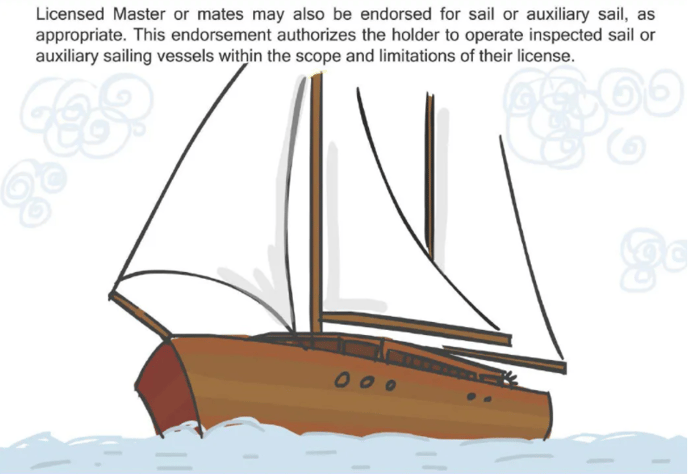
Whether you’re a sailor chasing the wind, a power boater in search of the next big fish, or a cruiser looking for the perfect sunset, earning your captain’s license will open the door to new opportunities.
Which captain’s license should I get?
The staff at Mariners Learning System recommends that you seek the highest-level license that you can qualify for. There are a couple of options, depending on your citizenship status and boating experience.
VIDEO: WHICH USCG CAPTAIN’S LICENSE SHOULD YOU CHOOSE?
Should I get an OUPV/Six-Pack or Masters license?
If you are just looking to become a safer boater by gaining additional knowledge, then the OUPV/Six-Pack is the license that we recommend.
If you are looking to use your license professionally, then we recommend that you consider skipping the OUPV/Six-Pack and go directly to the Master's level license.
Which captain’s license should I obtain if I want to do ___?
OUPV/Six-Pack
- Fishing charter
- Sailing charter
- Scuba diving boats
- Tour cruises
- Lower insurance rate
- Take 6 or less paying passengers out on an uninspected vessel
- Operate uninspected vessels of up to 100 gross tons
- Education and safety alone: do not plan on using it professionally
25/50/100 Ton Masters
- Ferry boats
- Harbor tour boats
- Sailing schooners
- Dive boat
- Whale-watching boat
- Water taxis
- Take 7 or more paying passengers out on an inspected vessel
- Operate uninspected and inspected vessels
To learn more, see our one-minute guide to finding out which license is best for you .
Which captain’s license should I get as a recreational boater?
Most recreational boaters choose to get the OUPV captain’s license , also known as the Six-Pack. This license is not required for recreational boaters, but many boaters with no intention of operating a commercial vessel go for their OUPV captain’s license because they want to brush up on safety and navigational skills. Plus, people like the pride of knowing they’ve achieved the designation.
You can also go for your Master captain’s license as a recreational boater, and you can achieve this license without first holding an OUPV/Six-Pack license.
Do I need a captain’s license to be a fishing guide?
If you want to be the captain of a fishing boat with paying passengers, you need a USCG captain’s license. To be a fishing guide for up to six passengers, you can obtain an OUPV/Six-Pack captain’s license. To be the captain of a ship with more than six paying passengers, a Master's license is necessary.
What are the license requirements to become a Sea Tow captain?
The minimum licensing requirement for Sea Tow is you must have an OUPV/Six-Pack license with a Towing Endorsement . However, many of the Sea Tow franchises require a Master's level license with a Towing Endorsement.
If the Sea Tow franchise is using a vessel of 26 feet or more, they will require you to get a Master level license with a Towing Endorsement.
We recommend going for the Masters + Towing Endorsement, if you qualify, to open up more job opportunities for you.
Which captain’s license is needed to drive a tugboat?
Mariners Learning System only offers courses that will help you get a captain’s license to have paying passengers aboard. The Towing Endorsement is added onto the captain’s license to assist disabled passenger vessels, for example- malfunctioning equipment or running out of fuel.
We recommend calling the National Maritime Center at (888) 427 - 5662. They may be able to give you more information on what you will need and where to go for a tugboat license.
How do I become a tour boat captain?
You can work as the captain of a commercial tour boat if you acquire a USCG-approved captain’s license. For small tours with up to six paying passengers, the OUPV/Six-Pack license is enough. For tours with more than seven or more passengers, you will need a Master captain’s license.
Networking and word of mouth are usually the best methods for landing a job as a tour boat captain. To get your foot in the door, you can start your career in the marine industry by working as a mate. This will give you invaluable local knowledge and help you get familiar with the ports and marinas in your area.
What kind of license do I need for a sailboat?
The OUPV/Six-Pack license is good for both power and sail. For those who want to run sailboats with seven or more paying passengers, a Master level captain’s license with a Sailing Endorsement is required.
What is the difference between a sailboat captain’s license vs. ASA and US sailing courses?
The American Sailing Association (ASA) and US Sailing Association both provide sailing certification programs. These programs are different from taking a course for the USCG sailing endorsement that can be added to your captain’s license. The Mariners Learning System auxiliary sailing endorsement online course will prepare you for this certification, whereas ASA and US Sailing courses will not.
How can I tell how many paying passengers I can have aboard and which license I’ll need?
If it is an inspected vessel with a Certificate of Inspection (COI) for more than 6 paying passengers, you will need a Master's license. If you do not have these, then you will not be able to take out more than 6 paying passengers.
Generally, boats with COIs are built for specific purposes, like water taxis and duck boats. The COI indicates how many paying passengers and the level of Masters license that is required.
Most recreational boats, like houseboats, are uninspected without a COI, and the OUPV/Six-Pack is needed to operate commercially.

Home Education Adult Sailing Sailing Certification Courses & Endorsements
Adult Sailing
Sailing certification courses & endorsements, us sailing keelboat certification system offers levels of certification for sailors & powerboaters, the us sailing keelboat certification system offers superior instruction that will make your dream escape a reality..
Whether you’re planning to cruise over the horizon, or sail in local waters near home, we’re here to help you gain the knowledge and the skills to achieve your goals. As the National Governing Body for sailing, US Sailing accredits only the top schools in the country. Today, the membership of US Sailing is over 1,700 organizations strong, and counting.
When you learn to sail at a US Sailing school, you’re learning from the best.
US Sailing, the National Governing Body for the Sport of Sailing, has been serving sailors since 1897 and our commitment to our more than 45,000 members is to provide a safe, fun and successful experience.
We developed a certification system that makes learning to sail easy and fun and supports you as you work to achieve your goals. All of our programming is designed to help you learn safely and with confidence and our educational materials are created by dedicated volunteer experts who share their passion and knowledge of sailing and education.
So take the first step by picking a course and find a school near you!
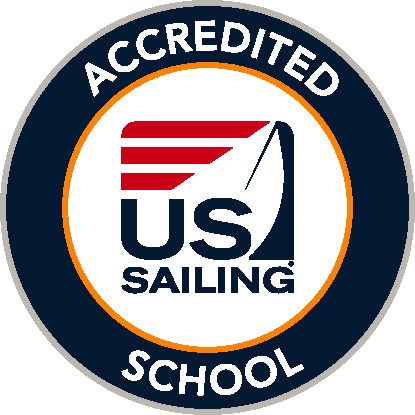
Looking for the best sailing education available? You’ve come to the right place.
Our varying courses offered at all levels of expertise, you'll learn from an experienced instructor who will provide you with opportunities to practice and direction to help you improve.
Find a School
Small Keelboat Track
- Basic Keelboat
- Performance Sailing
- Learn Basic Keelboat Online
Cruising Track
- Basic Cruising
- Bareboat Cruising
- Cruising Catamaran Endorsement
- Coastal Navigation
- Coastal Passage Making
- Celestial Navigation
- Powerboat Courses
Sailor Resources
Looking to charter a vessel in the mediterranean.
You'll need to a US Sailing International Proficiency Certificate to simplify the charter process and operate a vessel in compliance with EU Law. Apply for an IPC and use these other great resources to aid you in your education.
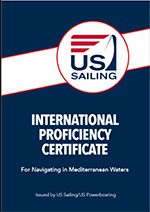
International Proficiency Certificate
Learn More
- New Sailor Resources
- Cruising and Chartering Resources
- Racing Tips
- Learn Online First
- Flotilla Calendar
Accreditation of Schools
Us sailing is always looking for high-quality schools to join our network. as a us sailing accredited school, you will have access to our school toolbox, be part of a cooperative marketing plan as well as opportunities for involvement with events like boat shows..
If you think that your school or organization might be a good fit in or network of schools, please fill out the form below. If you have any questions, please don’t hesitate to contact us at 401.342.7934.
Find out more!
Safety at Sea
- Safety at Sea Planning
- Hosting a US Sailing Championship

Andrew Clouston SVP Programs & Services Email Andrew Clouston

Betsy Alison Adult Director Email Betsy Alison 401-342-7914

Diana Emmanuelli Competition Manager Email Diana Emmanuelli 401-342-7912
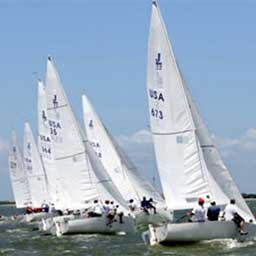
Karen Davidson Adult Program Coordinator Email Karen Davidson (401) 342-7934
Copyright ©2018-2024 United States Sailing Association. All rights reserved. US Sailing is a 501(c)3 organization. Website designed & developed by Design Principles, Inc. -->

Get Your Captain’s License Online with Mariners Learning System
Why Choose Mariners Learning System to Earn Your Captain’s License Online?
- 25,000+ graduates
- 98.7% pass rate
- They wrote both the course and the exam.
How to Get Started with the Captain’s License Course
- Decide which packages and media types makes most sense for you.
- Enroll and pay…you can even sign up to pay with no money down and no interest if paid within 6 months.
Sail With Us to Learn

Week-Long Liveaboard Courses Rare RYA Classes & Certifications
Catamaran Guru’s real-life practical methods combined with up-to-date sailing theory in lessons aboard recent model catamarans…or your own boat!
Prepare for certifications or take the first step aboard to embark on your dream life of boat ownership or cruising
Classes in S Florida and the Bahamas.
Estelle Cockcroft
Join our community.
Get the latest on catamaran news, sailing events, buying and selling tips, community happenings, webinars & seminars, and much more!

Leave a Comment Cancel Reply
Your email address will not be published. Required fields are marked *
Save my name, email, and website in this browser for the next time I comment.
Recent Posts

Top 10 Reasons to Sell (and Sail) Your Catamaran in Annapolis, MD
We have a new home in Annapolis! The office is located in Annapolis, Maryland
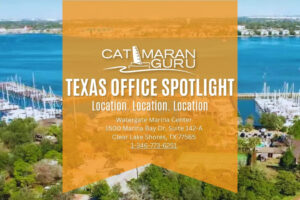
Top 10 Reasons to Sell (and Sail) Your Catamaran in Texas
Our Texas Office is located in the Watergate Marina Center in Clear Lake Shores,
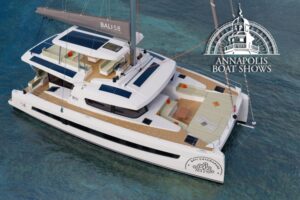
Annapolis Boat Show 2024
Meet with our team! Want to learn more about the Bali and Catana

Exploring the Catana OC 50 Catamaran: A Comprehensive Overview
The Catana OC 50 Catamaran, the latest addition to the Catana Ocean Class series,

For more than 30 years, we have been a part of the catamaran community and created Catamaran Guru™ to encourage and educate all the aspiring sailing out there. We understand the dream of traveling the world by catamaran and created a one-stop-shop to make that dream a reality for you.

- Stephen & Estelle
- Testimonials
Get Started
- Yacht Sales
- Used Yachts
- Charter Management
- Boat as Business Programs
- Seminars & Events
- Pontoon Boats
- Personal Watercraft
- nauticalknowhow
- Nautical Knots
- Tools and Calculators
Do You Really Need a Captain’s License? Here’s What You Need to Know
Do you need to be licensed as a captain to operate a boat? What’s the difference between a boat captain and a boat operator? How do you get a captain’s license if you need it, and how do you even know when you need one?
We get asked questions like this from people concerned they’re missing a license to operate their boat. Also, some are fearful that they may be at risk of fines from the Coast Guard or Marine Police for violating laws they didn’t even know existed.
USCG Licensing
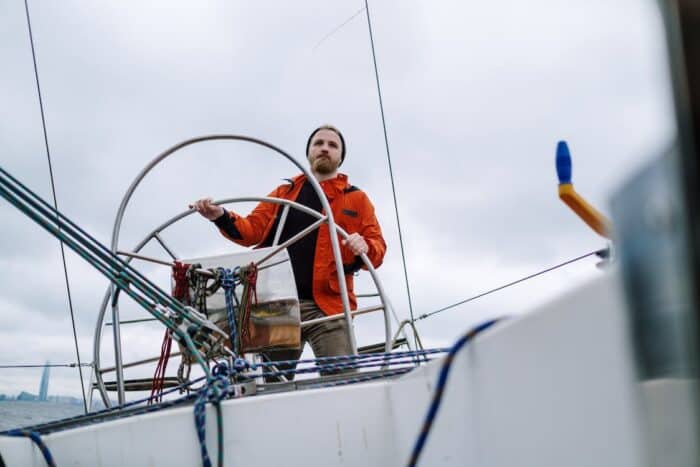
If you operate a personal boat recreationally, you do not need a United States Coast Guard boat captain’s license.
You do need to have a captain’s license if you plan to operate a vessel commercially. That could be anything from a chartered fishing boat where clients pay you to take them out to see so they can fish, to a tour boat operator, to the captain of a massive cruise ship.
As long as you are not accepting money to operate the boat from the people on board, you’re not considered a captain. Because you are not a captain, you do not require a captain’s license for most recreational vessels under 26 feet.
What Size Boat Requires a Captain’s License?
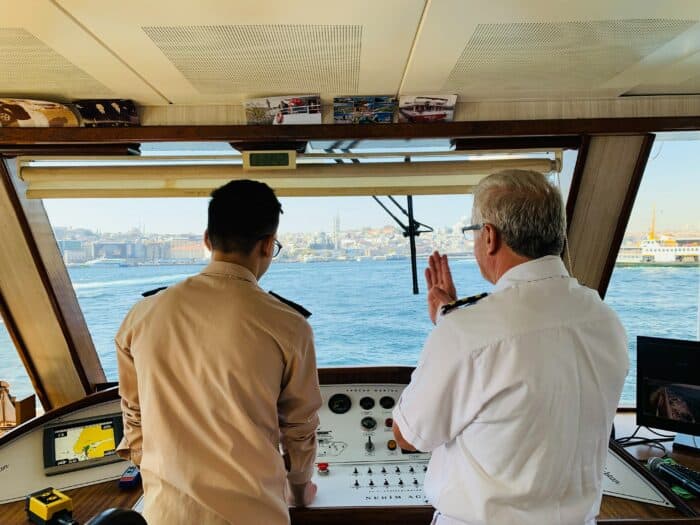
If you are operating a boat over 26 feet long, the United States Coast Guard requires a valid captain’s license. The larger a ship is, the harder it is to operate.
What is a Captain’s License?
A captain’s license is a credential issued by the United States Coast Guard when you qualify to become a boat captain. There are two main kinds of licenses you can get through the USCG. These are:
- OUPV/Six-Pack
- Master License
These licenses can be obtained after learning the coursework and passing the exam to qualify. You’ll also need to meet physical requirements, pass a background check, and have logged several boating hours to qualify. The courses cost several hundred dollars, and both could set you back over $1,000.
Once you have obtained a captain’s license, you can improve upon it later by adding endorsements for things like towing or sailing .
You must have a captain’s license to operate a boat commercially. The OUVP license allows you to operate a vessel with up to six paying passengers. The Master’s License will enable you to carry six or more.
What Does it Mean to Operate a Boat Commercially?

There are various jobs that you can do that would qualify as commercial. You don’t always have to have passengers on board to still be the boat captain who requires a license, either. Here are some examples of jobs you can do that would require you to have a captain’s license:
- Tugboat captain
- Running sea trials
- Charters for tourism or fishing
- Delivery captain transporting boats for clients
- Ferry captain
A Question from a Reader
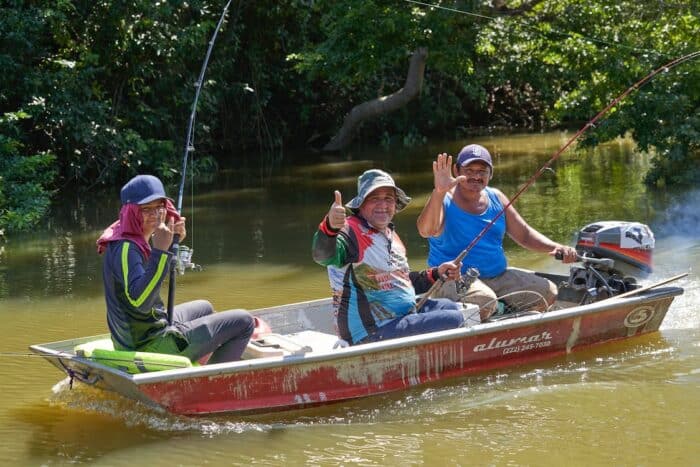
One of our readers sent us this, representing a situation that may be more common than you think. It covers that gray area where it can be unclear whether you’re working as a captain.
“A friend of mine was boarded by the Marine Police and the Coast Guard while fishing on the Chesapeake Bay. Since he had friends on board, they separated the people and asked them if they were paying him to take them out. Of course, they were not, they were just friends on a fishing trip.
What troubled me, and of course him, was the fact that he was told by the Coast Guard that if you share the cost of the fuel, that is considered a charter. Heck, most of us that fish all the time together share in the cost of the fishing with one another. Is this statement made by the Coast Guard true and could he have been fined for not having a captain’s license if his friends decided to help pay for some of his fuel costs? What regulations cover these sorts of rules, for if this is true a lot of us are in trouble.”
What is a Passenger for Hire?
It can be very confusing to know what is meant by ‘passenger for hire.’ Luckily, the term is clearly defined, as stated below.
- SEC. 506. PASSENGER FOR HIRE .
- Section 2101 of Title 46, United States Code, is amended by inserting between paragraphs (21) and (22) a new paragraph (21a) to read as follows:
- “(21a) ‘passenger for hire’ means a passenger for whom consideration is contributed as a condition of carriage on the vessel, whether directly or indirectly flowing to the owner, charterer, operator, agent, or any other person having an interest in the vessel..”
- DESCRIPTION – The determination of what constitutes the carriage of a “passenger for hire” must be made on a case by case basis. This determination is dependent upon the actual operation of a vessel and the flow of consideration as determined by the facts of each case. In general, there needs to be some form of tangible consideration or promise of performance being passed for a “passenger for hire” situation to exist.
- SEC. 507. CONSIDERATION
- Section 2101 of Title 46, United States Code, is amended by inserting between paragraphs (5) and (6) a new paragraph (5a) to read as follows:
- “(5a) ‘consideration’ means an economic benefit, inducement, right, or profit including pecuniary payment accruing to an individual, person, or entity, but not including a voluntary sharing of the actual expenses of the voyage, by monetary contribution or donation of fuel, food, beverage, or other supplies.” Additionally, employees or business clients that have not contributed for their carriage, and are carried for morale or entertainment purposes, are not considered as an exchange of consideration.
In a nutshell, this means a passenger for hire would not be on the boat if they weren’t paying to be there. They’re not a friend or family member or invited guest; they are a client or customer.
What Happens If You Operate a Commercial Vessel Without a Captain’s License?
In 2015, the United States Coast Guard began cracking down on non-commercial vessels operating as charter boats. If you get caught taking money from passengers on a vessel that isn’t licensed, there can be severe penalties. Aside from potential criminal charges that can be laid if a paying passenger were injured or killed, boat owners and operators can be fined as much as $35,000 per day for violations.
The Bottom Line
If you are operating a boat under 26 ft recreationally, you probably do not need a captain’s license. Many boaters get a captain’s license to improve their knowledge and skill set. Also, there’s some cache that comes along with being able to call yourself a captain legally.
As long as you are not charging passengers to be on your boat, then you don’t technically need to have a captain’s license. If you’re out on a boat with friends and everybody is chipping and money for gas and food, that doesn’t count as having paying passengers. In that case, you would not need a boat captain’s license either.
About Chris
Outdoors, I’m in my element, especially in the water. I know the importance of being geared up for anything. I do the deep digital dive, researching gear, boats and knowhow and love keeping my readership at the helm of their passions.
Categories : nauticalknowhow
Todd Feinroth on October 25, 2023
If I have a 24 foot powerboat and I want to take paying passengers do I still need an OUPV license?
Leave a Reply Cancel reply
Your email address will not be published. Required fields are marked *
Save my name, email, and website in this browser for the next time I comment.
More in nauticalknowhow

How to Tie a Boat to a Dock

How to Clean a Boat Cover

Everything You Need to Know About Your Boat’s Bilge Pump

4 Ways to Tie Your Boat Shoes

The People’s Poncho Review and Ratings

Oru Lake Kayak Review

What Is A Gunwale?

131 of the Best Hawaiian Boat Names

167 Patriotic Boat Names
About boatsafe.
Established in 1998, BoatSafe is your independent guide into the world of boating, fishing, and watersports. We provide expert insights and detailed guides to help you find products tailored to your needs and budget.
Contact Boatsafe
- Address: 4021 West Walnut Street. Rogers, AR 72756
- Phone: (479)339-4795
- Email: [email protected]
Site Navigation
- How We Test
- Corrections Policy
- Privacy Policy
- Terms & Conditions
- Editorial Policy
- Affiliate Disclosure
Our Reviews

All content is © Copyright 2024. All rights reserved.
Structured data
Items portrayed in this file.
- Flags with three horizontal stripes of yellow, green and blue color combination
- Flags of cities and villages of Sverdlovsk Oblast
- SVG sub-national flags of Russia
- Flag of Yekaterinburg
- Flags with fire
- SVG flags with an aspect ratio of 3:2
- Unknown date
- Template Unknown (author)
- PD-RU-exempt (flags)
Navigation menu
- Places - European, Western and Northern Russia
YEKATERINBURG: FACTORIES, URAL SIGHTS, YELTSIN AND THE WHERE NICHOLAS II WAS KILLED
Sverdlovsk oblast.
Sverdlovsk Oblast is the largest region in the Urals; it lies in the foothills of mountains and contains a monument indicating the border between Europe and Asia. The region covers 194,800 square kilometers (75,200 square miles), is home to about 4.3 million people and has a population density of 22 people per square kilometer. About 83 percent of the population live in urban areas. Yekaterinburg is the capital and largest city, with 1.5 million people. For Russians, the Ural Mountains are closely associated with Pavel Bazhov's tales and known for folk crafts such as Kasli iron sculpture, Tagil painting, and copper embossing. Yekaterinburg is the birthplace of Russia’s iron and steel industry, taking advantage of the large iron deposits in the Ural mountains. The popular Silver Ring of the Urals tourist route starts here.
In the summer you can follow in the tracks of Yermak, climb relatively low Ural mountain peaks and look for boulders seemingly with human faces on them. You can head to the Gemstone Belt of the Ural mountains, which used to house emerald, amethyst and topaz mines. In the winter you can go ice fishing, ski and cross-country ski.
Sverdlovsk Oblast and Yekaterinburg are located near the center of Russia, at the crossroads between Europe and Asia and also the southern and northern parts of Russia. Winters are longer and colder than in western section of European Russia. Snowfalls can be heavy. Winter temperatures occasionally drop as low as - 40 degrees C (-40 degrees F) and the first snow usually falls in October. A heavy winter coat, long underwear and good boots are essential. Snow and ice make the sidewalks very slippery, so footwear with a good grip is important. Since the climate is very dry during the winter months, skin moisturizer plus lip balm are recommended. Be alert for mud on street surfaces when snow cover is melting (April-May). Patches of mud create slippery road conditions.
Yekaterinburg
Yekaterinburg (kilometer 1818 on the Trans-Siberian Railway) is the fourth largest city in Russia, with of 1.5 million and growth rate of about 12 percent, high for Russia. Located in the southern Ural mountains, it was founded by Peter the Great and named after his wife Catherine, it was used by the tsars as a summer retreat and is where tsar Nicholas II and his family were executed and President Boris Yeltsin lived most of his life and began his political career. The city is near the border between Europe and Asia.
Yekaterinburg (also spelled Ekaterinburg) is located on the eastern slope of the Ural Mountains in the headwaters of the Iset and Pyshma Rivers. The Iset runs through the city center. Three ponds — Verkh-Isetsky, Gorodskoy and Nizhne-Isetsky — were created on it. Yekaterinburg has traditionally been a city of mining and was once the center of the mining industry of the Urals and Siberia. Yekaterinburg remains a major center of the Russian armaments industry and is sometimes called the "Pittsburgh of Russia.". A few ornate, pastel mansions and wide boulevards are reminders of the tsarist era. The city is large enough that it has its own Metro system but is characterized mostly by blocky Soviet-era apartment buildings. The city has advanced under President Vladimir Putin and is now one of the fastest growing places in Russia, a country otherwise characterized by population declines
Yekaterinburg is technically an Asian city as it lies 32 kilometers east of the continental divide between Europe and Asia. The unofficial capital of the Urals, a key region in the Russian heartland, it is second only to Moscow in terms of industrial production and capital of Sverdlovsk oblast. Among the important industries are ferrous and non-ferrous metallurgy, machine building and metalworking, chemical and petrochemicals, construction materials and medical, light and food industries. On top of being home of numerous heavy industries and mining concerns, Yekaterinburg is also a major center for industrial research and development and power engineering as well as home to numerous institutes of higher education, technical training, and scientific research. In addition, Yekaterinburg is the largest railway junction in Russia: the Trans-Siberian Railway passes through it, the southern, northern, western and eastern routes merge in the city.
Accommodation: There are two good and affordable hotels — the 3-star Emerald and Parus hotels — located close to the city's most popular landmarks and main transport interchanges in the center of Yekaterinburg. Room prices start at RUB 1,800 per night.
History of Yekaterinburg
Yekaterinburg was founded in 1723 by Peter the Great and named after his wife Catherine I. It was used by the tsars as a summer retreat but was mainly developed as metalworking and manufacturing center to take advantage of the large deposits of iron and other minerals in the Ural mountains. It is best known to Americans as the place where the last Tsar and his family were murdered by the Bolsheviks in 1918 and near where American U-2 spy plane, piloted by Gary Powers, was shot down in 1960.
Peter the Great recognized the importance of the iron and copper-rich Urals region for Imperial Russia's industrial and military development. In November 1723, he ordered the construction of a fortress factory and an ironworks in the Iset River Valley, which required a dam for its operation. In its early years Yekaterinburg grew rich from gold and other minerals and later coal. The Yekaterinburg gold rush of 1745 created such a huge amount of wealth that one rich baron of that time hosted a wedding party that lasted a year. By the mid-18th century, metallurgical plants had sprung up across the Urals to cast cannons, swords, guns and other weapons to arm Russia’s expansionist ambitions. The Yekaterinburg mint produced most of Russia's coins. Explorations of the Trans-Baikal and Altai regions began here in the 18th century.
Iron, cast iron and copper were the main products. Even though Iron from the region went into the Eiffel Tower, the main plant in Yekaterinburg itself was shut down in 1808. The city still kept going through a mountain factory control system of the Urals. The first railway in the Urals was built here: in 1878, the Yekaterinburg-Perm railway branch connected the province's capital with the factories of the Middle Urals.
In the Soviet era the city was called Sverdlovsk (named after Yakov Sverdlov, the man who organized Nicholas II's execution). During the first five-year plans the city became industrial — old plants were reconstructed, new ones were built. The center of Yekaterinburg was formed to conform to the historical general plan of 1829 but was the layout was adjusted around plants and factories. In the Stalin era the city was a major gulag transhipment center. In World War II, many defense-related industries were moved here. It and the surrounding area were a center of the Soviet Union's military industrial complex. Soviet tanks, missiles and aircraft engines were made in the Urals. During the Cold War era, Yekaterinburg was a center of weapons-grade uranium enrichment and processing, warhead assembly and dismantlement. In 1979, 64 people died when anthrax leaked from a biological weapons facility. Yekaterinburg was a “Closed City” for 40 years during the Cold Soviet era and was not open to foreigners until 1991
In the early post-Soviet era, much like Pittsburgh in the 1970s, Yekaterinburg had a hard struggle d to cope with dramatic economic changes that have made its heavy industries uncompetitive on the world market. Huge defense plants struggled to survive and the city was notorious as an organized crime center in the 1990s, when its hometown boy Boris Yeltsin was President of Russia. By the 2000s, Yekaterinburg’s retail and service was taking off, the defense industry was reviving and it was attracting tech industries and investments related to the Urals’ natural resources. By the 2010s it was vying to host a world exhibition in 2020 (it lost, Dubai won) and it had McDonald’s, Subway, sushi restaurants, and Gucci, Chanel and Armani. There were Bentley and Ferrari dealerships but they closed down
Transportation in Yekaterinburg
Getting There: By Plane: Yekaterinburg is a three-hour flight from Moscow with prices starting at RUB 8,000, or a 3-hour flight from Saint Petersburg starting from RUB 9,422 (direct round-trip flight tickets for one adult passenger). There are also flights from Frankfurt, Istanbul, China and major cities in the former Soviet Union.
By Train: Yekaterinburg is a major stop on the Trans-Siberian Railway. Daily train service is available to Moscow and many other Russian cities.Yekaterinburg is a 32-hour train ride from Moscow (tickets RUB 8,380 and above) or a 36-hour train ride from Saint Petersburg (RUB 10,300 and above). The ticket prices are round trip for a berth in a sleeper compartment for one adult passenger). By Car: a car trip from Moscow to Yekateringburg is 1,787 kilometers long and takes about 18 hours. The road from Saint Petersburg is 2,294 kilometers and takes about 28 hours.
Regional Transport: The region's public transport includes buses and suburban electric trains. Regional trains provide transport to larger cities in the Ural region. Buses depart from Yekaterinburg’s two bus stations: the Southern Bus Station and the Northern Bus Station.
Regional Transport: According the to Association for Safe International Road Travel (ASIRT): “Public transportation is well developed. Overcrowding is common. Fares are low. Service is efficient. Buses are the main form of public transport. Tram network is extensive. Fares are reasonable; service is regular. Trams are heavily used by residents, overcrowding is common. Purchase ticket after boarding. Metro runs from city center to Uralmash, an industrial area south of the city. Metro ends near the main railway station. Fares are inexpensive.
“Traffic is congested in city center. Getting around by car can be difficult. Route taxis (minivans) provide the fastest transport. They generally run on specific routes, but do not have specific stops. Drivers stop where passengers request. Route taxis can be hailed. Travel by bus or trolleybuses may be slow in rush hour. Trams are less affected by traffic jams. Trolley buses (electric buses) cannot run when temperatures drop below freezing.”
Entertainment, Sports and Recreation in Yekaterinburg
The performing arts in Yekaterinburg are first rate. The city has an excellent symphony orchestra, opera and ballet theater, and many other performing arts venues. Tickets are inexpensive. The Yekaterinburg Opera and Ballet Theater is lavishly designed and richly decorated building in the city center of Yekaterinburg. The theater was established in 1912 and building was designed by architect Vladimir Semyonov and inspired by the Vienna Opera House and the Theater of Opera and Ballet in Odessa.
Vaynera Street is a pedestrian only shopping street in city center with restaurants, cafes and some bars. But otherwise Yekaterinburg's nightlife options are limited. There are a handful of expensive Western-style restaurants and bars, none of them that great. Nightclubs serve the city's nouveau riche clientele. Its casinos have closed down. Some of them had links with organized crime. New dance clubs have sprung up that are popular with Yekaterinburg's more affluent youth.
Yekaterinburg's most popular spectator sports are hockey, basketball, and soccer. There are stadiums and arenas that host all three that have fairly cheap tickets. There is an indoor water park and lots of parks and green spaces. The Urals have many lakes, forests and mountains are great for hiking, boating, berry and mushroom hunting, swimming and fishing. Winter sports include cross-country skiing and ice skating. Winter lasts about six months and there’s usually plenty of snow. The nearby Ural Mountains however are not very high and the downhill skiing opportunities are limited..
Sights in Yekaterinburg
Sights in Yekaterinburg include the Museum of City Architecture and Ural Industry, with an old water tower and mineral collection with emeralds. malachite, tourmaline, jasper and other precious stone; Geological Alley, a small park with labeled samples of minerals found in the Urals region; the Ural Geology Museum, which houses an extensive collection of stones, gold and gems from the Urals; a monument marking the border between Europe and Asia; a memorial for gulag victims; and a graveyard with outlandish memorials for slain mafia members.
The Military History Museum houses the remains of the U-2 spy plane shot down in 1960 and locally made tanks and rocket launchers. The fine arts museum contains paintings by some of Russia's 19th-century masters. Also worth a look are the History an Local Studies Museum; the Political History and Youth Museum; and the University and Arboretum. Old wooden houses can be seen around Zatoutstovsya ulitsa and ulitsa Belinskogo. Around the city are wooded parks, lakes and quarries used to harvest a variety of minerals. Weiner Street is the main street of Yekaterinburg. Along it are lovely sculptures and 19th century architecture. Take a walk around the unique Literary Quarter
Plotinka is a local meeting spot, where you will often find street musicians performing. Plotinka can be described as the center of the city's center. This is where Yekaterinburg holds its biggest events: festivals, seasonal fairs, regional holiday celebrations, carnivals and musical fountain shows. There are many museums and open-air exhibitions on Plotinka. Plotinka is named after an actual dam of the city pond located nearby (“plotinka” means “a small dam” in Russian).In November 1723, Peter the Great ordered the construction of an ironworks in the Iset River Valley, which required a dam for its operation. “Iset” can be translated from Finnish as “abundant with fish”. This name was given to the river by the Mansi — the Finno-Ugric people dwelling on the eastern slope of the Northern Urals.
Vysotsky and Iset are skyscrapers that are 188.3 meters and 209 meters high, respectively. Fifty-story-high Iset has been described by locals as the world’s northernmost skyscraper. Before the construction of Iset, Vysotsky was the tallest building of Yekaterinburg and Russia (excluding Moscow). A popular vote has decided to name the skyscraper after the famous Soviet songwriter, singer and actor Vladimir Vysotsky. and the building was opened on November 25, 2011. There is a lookout at the top of the building, and the Vysotsky museum on its second floor. The annual “Vysotsky climb” (1137 steps) is held there, with a prize of RUB 100,000. While Vysotsky serves as an office building, Iset, owned by the Ural Mining and Metallurgical Company, houses 225 premium residential apartments ranging from 80 to 490 square meters in size.
Boris Yeltsin Presidential Center
The Boris Yeltsin Presidential Center (in the city center: ul. Yeltsina, 3) is a non-governmental organization named after the first president of the Russian Federation. The Museum of the First President of Russia as well as his archives are located in the Center. There is also a library, educational and children's centers, and exposition halls. Yeltsin lived most of his life and began his political career in Yekaterinburg. He was born in Butka about 200 kilometers east of Yekaterinburg.
The core of the Center is the Museum. Modern multimedia technologies help animate the documents, photos from the archives, and artifacts. The Yeltsin Museum holds collections of: propaganda posters, leaflets, and photos of the first years of the Soviet regime; portraits and portrait sculptures of members of Politburo of the Central Committee of the Communist Party of various years; U.S.S.R. government bonds and other items of the Soviet era; a copy of “One Day in the Life of Ivan Denisovich” by Alexander Solzhenitsyn, published in the “Novy Mir” magazine (#11, 1962); perestroika-era editions of books by Alexander Solzhenitsyn, Vasily Grossman, and other authors; theater, concert, and cinema posters, programs, and tickets — in short, all of the artifacts of the perestroika era.
The Yeltsin Center opened in 2012. Inside you will also find an art gallery, a bookstore, a gift shop, a food court, concert stages and a theater. There are regular screenings of unique films that you will not find anywhere else. Also operating inside the center, is a scientific exploritorium for children. The center was designed by Boris Bernaskoni. Almost from the its very opening, the Yeltsin Center has been accused by members of different political entities of various ideological crimes. The museum is open Tuesday to Sunday, from 10:00am to 9:00pm.
Where Nicholas II was Executed
On July, 17, 1918, during this reign of terror of the Russian Civil War, former-tsar Nicholas II, his wife, five children (the 13-year-old Alexis, 22-year-old Olga, 19-year-old Maria and 17-year-old Anastasia)the family physician, the cook, maid, and valet were shot to death by a Red Army firing squad in the cellar of the house they were staying at in Yekaterinburg.
Ipatiev House (near Church on the Blood, Ulitsa Libknekhta) was a merchant's house where Nicholas II and his family were executed. The house was demolished in 1977, on the orders of an up and coming communist politician named Boris Yeltsin. Yeltsin later said that the destruction of the house was an "act of barbarism" and he had no choice because he had been ordered to do it by the Politburo,
The site is marked with s cross with the photos of the family members and cross bearing their names. A small wooden church was built at the site. It contains paintings of the family. For a while there were seven traditional wooden churches. Mass is given ay noon everyday in an open-air museum. The Church on the Blood — constructed to honor Nicholas II and his family — was built on the part of the site in 1991 and is now a major place of pilgrimage.
Nicholas and his family where killed during the Russian civil war. It is thought the Bolsheviks figured that Nicholas and his family gave the Whites figureheads to rally around and they were better of dead. Even though the death orders were signed Yakov Sverdlov, the assassination was personally ordered by Lenin, who wanted to get them out of sight and out of mind. Trotsky suggested a trial. Lenin nixed the idea, deciding something had to be done about the Romanovs before White troops approached Yekaterinburg. Trotsky later wrote: "The decision was not only expedient but necessary. The severity of he punishment showed everyone that we would continue to fight on mercilessly, stopping at nothing."
Ian Frazier wrote in The New Yorker: “Having read a lot about the end of Tsar Nicholas II and his family and servants, I wanted to see the place in Yekaterinburg where that event occurred. The gloomy quality of this quest depressed Sergei’s spirits, but he drove all over Yekaterinburg searching for the site nonetheless. Whenever he stopped and asked a pedestrian how to get to the house where Nicholas II was murdered, the reaction was a wince. Several people simply walked away. But eventually, after a lot of asking, Sergei found the location. It was on a low ridge near the edge of town, above railroad tracks and the Iset River. The house, known as the Ipatiev House, was no longer standing, and the basement where the actual killings happened had been filled in. I found the blankness of the place sinister and dizzying. It reminded me of an erasure done so determinedly that it had worn a hole through the page. [Source: Ian Frazier, The New Yorker, August 3, 2009, Frazier is author of “Travels in Siberia” (2010)]
“The street next to the site is called Karl Liebknecht Street. A building near where the house used to be had a large green advertisement that said, in English, “LG—Digitally Yours.” On an adjoining lot, a small chapel kept the memory of the Tsar and his family; beneath a pedestal holding an Orthodox cross, peonies and pansies grew. The inscription on the pedestal read, “We go down on our knees, Russia, at the foot of the tsarist cross.”
Books: The Romanovs: The Final Chapter by Robert K. Massie (Random House, 1995); The Fall of the Romanovs by Mark D. Steinberg and Vladimir Khrustalëv (Yale, 1995);
See Separate Article END OF NICHOLAS II factsanddetails.com
Execution of Nicholas II
According to Robert Massie K. Massie, author of Nicholas and Alexandra, Nicholas II and his family were awakened from their bedrooms around midnight and taken to the basement. They were told they were to going to take some photographs of them and were told to stand behind a row of chairs.
Suddenly, a group of 11 Russians and Latvians, each with a revolver, burst into the room with orders to kill a specific person. Yakob Yurovsky, a member of the Soviet executive committee, reportedly shouted "your relatives are continuing to attack the Soviet Union.” After firing, bullets bouncing off gemstones hidden in the corsets of Alexandra and her daughters ricocheted around the room like "a shower of hail," the soldiers said. Those that were still breathing were killed with point black shots to the head.
The three sisters and the maid survived the first round thanks to their gems. They were pressed up against a wall and killed with a second round of bullets. The maid was the only one that survived. She was pursued by the executioners who stabbed her more than 30 times with their bayonets. The still writhing body of Alexis was made still by a kick to the head and two bullets in the ear delivered by Yurovsky himself.
Yurovsky wrote: "When the party entered I told the Romanovs that in view of the fact their relatives continued their offensive against Soviet Russia, the Executive Committee of the Urals Soviet had decided to shoot them. Nicholas turned his back to the detachment and faced his family. Then, as if collecting himself, he turned around, asking, 'What? What?'"
"[I] ordered the detachment to prepare. Its members had been previously instructed whom to shoot and to am directly at the heart to avoid much blood and to end more quickly. Nicholas said no more. he turned again to his family. The others shouted some incoherent exclamations. All this lasted a few seconds. Then commenced the shooting, which went on for two or three minutes. [I] killed Nicholas on the spot."
Nicholas II’s Initial Burial Site in Yekaterinburg
Ganina Yama Monastery (near the village of Koptyaki, 15 kilometers northwest of Yekaterinburg) stands near the three-meter-deep pit where some the remains of Nicholas II and his family were initially buried. The second burial site — where most of the remains were — is in a field known as Porosyonkov (56.9113628°N 60.4954326°E), seven kilometers from Ganina Yama.
On visiting Ganina Yama Monastery, one person posted in Trip Advisor: “We visited this set of churches in a pretty park with Konstantin from Ekaterinburg Guide Centre. He really brought it to life with his extensive knowledge of the history of the events surrounding their terrible end. The story is so moving so unless you speak Russian, it is best to come here with a guide or else you will have no idea of what is what.”
In 1991, the acid-burned remains of Nicholas II and his family were exhumed from a shallow roadside mass grave in a swampy area 12 miles northwest of Yekaterinburg. The remains had been found in 1979 by geologist and amateur archeologist Alexander Avdonin, who kept the location secret out of fear that they would be destroyed by Soviet authorities. The location was disclosed to a magazine by one his fellow discovers.
The original plan was to throw the Romanovs down a mine shaft and disposes of their remains with acid. They were thrown in a mine with some grenades but the mine didn't collapse. They were then carried by horse cart. The vats of acid fell off and broke. When the carriage carrying the bodies broke down it was decided the bury the bodies then and there. The remaining acid was poured on the bones, but most of it was soaked up the ground and the bones largely survived.
After this their pulses were then checked, their faces were crushed to make them unrecognizable and the bodies were wrapped in bed sheets loaded onto a truck. The "whole procedure," Yurovsky said took 20 minutes. One soldiers later bragged than he could "die in peace because he had squeezed the Empress's -------."
The bodies were taken to a forest and stripped, burned with acid and gasoline, and thrown into abandoned mine shafts and buried under railroad ties near a country road near the village of Koptyaki. "The bodies were put in the hole," Yurovsky wrote, "and the faces and all the bodies, generally doused with sulfuric acid, both so they couldn't be recognized and prevent a stink from them rotting...We scattered it with branches and lime, put boards on top and drove over it several times—no traces of the hole remained.
Shortly afterwards, the government in Moscow announced that Nicholas II had been shot because of "a counterrevolutionary conspiracy." There was no immediate word on the other members of the family which gave rise to rumors that other members of the family had escaped. Yekaterinburg was renamed Sverdlov in honor of the man who signed the death orders.
For seven years the remains of Nicholas II, Alexandra, three of their daughters and four servants were stored in polyethylene bags on shelves in the old criminal morgue in Yekaterunburg. On July 17, 1998, Nicholas II and his family and servants who were murdered with him were buried Peter and Paul Fortress in St. Petersburg along with the other Romanov tsars, who have been buried there starting with Peter the Great. Nicholas II had a side chapel built for himself at the fortress in 1913 but was buried in a new crypt.
Near Yekaterinburg
Factory-Museum of Iron and Steel Metallurgy (in Niznhy Tagil 80 kilometers north of Yekaterinburg) a museum with old mining equipment made at the site of huge abandoned iron and steel factory. Officially known as the Factory-Museum of the History of the Development of Iron and Steel Metallurgy, it covers an area of 30 hectares and contains a factory founded by the Demidov family in 1725 that specialized mainly in the production of high-quality cast iron and steel. Later, the foundry was renamed after Valerian Kuybyshev, a prominent figure of the Communist Party.
The first Russian factory museum, the unusual museum demonstrates all stages of metallurgy and metal working. There is even a blast furnace and an open-hearth furnace. The display of factory equipment includes bridge crane from 1892) and rolling stock equipment from the 19th-20th centuries. In Niznhy Tagil contains some huge blocks of malachite and
Nizhnyaya Sinyachikha (180 kilometers east-northeast of Yekaterinburg) has an open air architecture museum with log buildings, a stone church and other pre-revolutionary architecture. The village is the creation of Ivan Samoilov, a local activist who loved his village so much he dedicated 40 years of his life to recreating it as the open-air museum of wooden architecture.
The stone Savior Church, a good example of Siberian baroque architecture. The interior and exterior of the church are exhibition spaces of design. The houses are very colorful. In tsarist times, rich villagers hired serfs to paint the walls of their wooden izbas (houses) bright colors. Old neglected buildings from the 17th to 19th centuries have been brought to Nizhnyaya Sinyachikha from all over the Urals. You will see the interior design of the houses and hear stories about traditions and customs of the Ural farmers.
Verkhoturye (330 kilometers road from Yekaterinburg) is the home a 400-year-old monastery that served as 16th century capital of the Urals. Verkhoturye is a small town on the Tura River knows as the Jerusalem of the Urals for its many holy places, churches and monasteries. The town's main landmark is its Kremlin — the smallest in Russia. Pilgrims visit the St. Nicholas Monastery to see the remains of St. Simeon of Verkhoturye, the patron saint of fishermen.
Ural Mountains
Ural Mountains are the traditional dividing line between Europe and Asia and have been a crossroads of Russian history. Stretching from Kazakhstan to the fringes of the Arctic Kara Sea, the Urals lie almost exactly along the 60 degree meridian of longitude and extend for about 2,000 kilometers (1,300 miles) from north to south and varies in width from about 50 kilometers (30 miles) in the north and 160 kilometers (100 miles) the south. At kilometers 1777 on the Trans-Siberian Railway there is white obelisk with "Europe" carved in Russian on one side and "Asia" carved on the other.
The eastern side of the Urals contains a lot of granite and igneous rock. The western side is primarily sandstone and limestones. A number of precious stones can be found in the southern part of the Urals, including emeralds. malachite, tourmaline, jasper and aquamarines. The highest peaks are in the north. Mount Narodnaya is the highest of all but is only 1884 meters (6,184 feet) high. The northern Urals are covered in thick forests and home to relatively few people.
Like the Appalachian Mountains in the eastern United States, the Urals are very old mountains — with rocks and sediments that are hundreds of millions years old — that were one much taller than they are now and have been steadily eroded down over millions of years by weather and other natural processes to their current size. According to Encyclopedia Britannica: “The rock composition helps shape the topography: the high ranges and low, broad-topped ridges consist of quartzites, schists, and gabbro, all weather-resistant. Buttes are frequent, and there are north–south troughs of limestone, nearly all containing river valleys. Karst topography is highly developed on the western slopes of the Urals, with many caves, basins, and underground streams. The eastern slopes, on the other hand, have fewer karst formations; instead, rocky outliers rise above the flattened surfaces. Broad foothills, reduced to peneplain, adjoin the Central and Southern Urals on the east.
“The Urals date from the structural upheavals of the Hercynian orogeny (about 250 million years ago). About 280 million years ago there arose a high mountainous region, which was eroded to a peneplain. Alpine folding resulted in new mountains, the most marked upheaval being that of the Nether-Polar Urals...The western slope of the Urals is composed of middle Paleozoic sedimentary rocks (sandstones and limestones) that are about 350 million years old. In many places it descends in terraces to the Cis-Ural depression (west of the Urals), to which much of the eroded matter was carried during the late Paleozoic (about 300 million years ago). Found there are widespread karst (a starkly eroded limestone region) and gypsum, with large caverns and subterranean streams. On the eastern slope, volcanic layers alternate with sedimentary strata, all dating from middle Paleozoic times.”
Southern Urals
The southern Urals are characterized by grassy slopes and fertile valleys. The middle Urals are a rolling platform that barely rises above 300 meters (1,000 feet). This region is rich in minerals and has been heavily industrialized. This is where you can find Yekaterinburg (formally Sverdlovsk), the largest city in the Urals.
Most of the Southern Urals are is covered with forests, with 50 percent of that pine-woods, 44 percent birch woods, and the rest are deciduous aspen and alder forests. In the north, typical taiga forests are the norm. There are patches of herbal-poaceous steppes, northem sphagnous marshes and bushy steppes, light birch forests and shady riparian forests, tall-grass mountainous meadows, lowland ling marshes and stony placers with lichen stains. In some places there are no large areas of homogeneous forests, rather they are forests with numerous glades and meadows of different size.
In the Ilmensky Mountains Reserve in the Southern Urals, scientists counted 927 vascular plants (50 relicts, 23 endemic species), about 140 moss species, 483 algae species and 566 mushroom species. Among the species included into the Red Book of Russia are feather grass, downy-leaved feather grass, Zalessky feather grass, moccasin flower, ladies'-slipper, neottianthe cucullata, Baltic orchis, fen orchis, helmeted orchis, dark-winged orchis, Gelma sandwart, Krasheninnikov sandwart, Clare astragalus.
The fauna of the vertebrate animals in the Reserve includes 19 fish, 5 amphibian and 5 reptile. Among the 48 mammal species are elks, roe deer, boars, foxes, wolves, lynxes, badgers, common weasels, least weasels, forest ferrets, Siberian striped weasel, common marten, American mink. Squirrels, beavers, muskrats, hares, dibblers, moles, hedgehogs, voles are quite common, as well as chiropterans: pond bat, water bat, Brandt's bat, whiskered bat, northern bat, long-eared bat, parti-coloured bat, Nathusius' pipistrelle. The 174 bird bird species include white-tailed eagles, honey hawks, boreal owls, gnome owls, hawk owls, tawny owls, common scoters, cuckoos, wookcocks, common grouses, wood grouses, hazel grouses, common partridges, shrikes, goldenmountain thrushes, black- throated loons and others.
Activities and Places in the Ural Mountains
The Urals possess beautiful natural scenery that can be accessed from Yekaterinburg with a rent-a-car, hired taxi and tour. Travel agencies arrange rafting, kayaking and hiking trips. Hikes are available in the taiga forest and the Urals. Trips often include walks through the taiga to small lakes and hikes into the mountains and excursions to collect mushrooms and berries and climb in underground caves. Mellow rafting is offered in a relatively calm six kilometer section of the River Serga. In the winter visitor can enjoy cross-mountains skiing, downhill skiing, ice fishing, dog sledding, snow-shoeing and winter hiking through the forest to a cave covered with ice crystals.
Lake Shartash (10 kilometers from Yekaterinburg) is where the first Ural gold was found, setting in motion the Yekaterinburg gold rush of 1745, which created so much wealth one rich baron of that time hosted a wedding party that lasted a year. The area around Shartash Lake is a favorite picnic and barbecue spot of the locals. Getting There: by bus route No. 50, 054 or 54, with a transfer to suburban commuter bus route No. 112, 120 or 121 (the whole trip takes about an hour), or by car (10 kilometers drive from the city center, 40 minutes).
Revun Rapids (90 kilometers road from Yekaterinburg near Beklenishcheva village) is a popular white water rafting places On the nearby cliffs you can see the remains of a mysterious petroglyph from the Paleolithic period. Along the steep banks, you may notice the dark entrance of Smolinskaya Cave. There are legends of a sorceress who lived in there. The rocks at the riverside are suited for competitive rock climbers and beginners. Climbing hooks and rings are hammered into rocks. The most fun rafting is generally in May and June.
Olenii Ruchii National Park (100 kilometers west of Yekaterinburg) is the most popular nature park in Sverdlovsk Oblast and popular weekend getaway for Yekaterinburg residents. Visitors are attracted by the beautiful forests, the crystal clear Serga River and picturesque rocks caves. There are some easy hiking routes: the six-kilometer Lesser Ring and the 15-kilometer Greater Ring. Another route extends for 18 km and passes by the Mitkinsky Mine, which operated in the 18th-19th centuries. It's a kind of an open-air museum — you can still view mining an enrichment equipment here. There is also a genuine beaver dam nearby.
Among the other attractions at Olenii Ruchii are Druzhba (Friendship) Cave, with passages that extend for about 500 meters; Dyrovaty Kamen (Holed Stone), created over time by water of Serga River eroding rock; and Utoplennik (Drowned Man), where you can see “The Angel of Sole Hope”., created by the Swedish artist Lehna Edwall, who has placed seven angels figures in different parts of the world to “embrace the planet, protecting it from fear, despair, and disasters.”
Image Sources: Wikimedia Commons
Text Sources: Federal Agency for Tourism of the Russian Federation (official Russia tourism website russiatourism.ru ), Russian government websites, UNESCO, Wikipedia, Lonely Planet guides, New York Times, Washington Post, Los Angeles Times, National Geographic, The New Yorker, Bloomberg, Reuters, Associated Press, AFP, Yomiuri Shimbun and various books and other publications.
Updated in September 2020
- Google+
Page Top
This site contains copyrighted material the use of which has not always been authorized by the copyright owner. Such material is made available in an effort to advance understanding of country or topic discussed in the article. This constitutes 'fair use' of any such copyrighted material as provided for in section 107 of the US Copyright Law. In accordance with Title 17 U.S.C. Section 107, the material on this site is distributed without profit. If you wish to use copyrighted material from this site for purposes of your own that go beyond 'fair use', you must obtain permission from the copyright owner. If you are the copyright owner and would like this content removed from factsanddetails.com, please contact me.

- Find A School
- Certifications
- North U Sail Trim
- Inside Sailing with Peter Isler
- Docking Made Easy
- Study Quizzes
- Bite-sized Lessons
- Fun Quizzes
- Sailing Challenge
INTERNATIONAL PROFICIENCY CERTIFICATE

American Sailing's New IPC
American Sailing's updated IPC now has the convenience, portability, and durability of an ID card. The front of the IPC contains vital information of the holder, this includes their photograph, name, home address, nationality, ASID, birthdate, expiration, as well as a VHF endorsement from American Sailing.
The back of the IPC is designed specifically for charter companies. It summarizes and describes what the IPC is as well as a QR code for this very page for more details.
IPC CREDENTIALS

ASA 101 KEELBOAT SAILING 1

ASA 103 Coastal Cruising

ASA 104 Bareboat Cruising
Missing a certification, what is the ipc.

American Sailing - Who We Are
The American Sailing Association was founded in 1983 with a simply stated mission: to teach people to sail safely and confidently. To achieve that goal, the ASA set out to establish standards against which to measure a sailor's level of knowledge and skill, the first such unified standards in the U.S. to apply to sailors in keelboats.
Today, the ASA is an association of sailing schools, charter companies, professional sailing instructors, and sailors, with over 400+ affiliated sailing schools located throughout the U.S., as well as in the Caribbean, Europe, Central America, and Asia. These accredited schools offer ASA certification to individuals who meet the requirements for a given level. To date, ASA schools have certified over half a million sailors!
The ASA system has eight primary levels of student certification from Basic Keelboat all the way to Offshore Passagemaking. Whether your goal is to skipper a bareboat charter in the Caribbean or to crew confidently on a short weekend sail, the ASA's sailing-education system will guide you as you learn the theory behind sailing, practice the skills needed to handle a sailboat, and build the foundation of knowledge that will enable you to navigate a vessel safely and within the law.
Learning to sail is just the beginning. Through partnerships with environmental organizations, American Sailing is becoming a leader in the fight to protect our oceans. Through American Sailing initiatives, underrepresented communities are invited to share in the sailing lifestyle. Our members are embarking on sailing adventures around the world while utilizing the knowledge they have gained in ASA classrooms. American Sailing is a model for how a modern-day organization can work to build an inclusive environment for all.
Sailing is for everyone.
Want to apply for the ipc?

- Learn To Sail
- Mobile Apps
- Online Courses
- Upcoming Courses
- Sailor Resources
- ASA Log Book
- Bite Sized Lessons
- Knots Made Easy
- Catamaran Challenge
- Sailing Vacations
- Sailing Cruises
- Charter Resources
- International Proficiency Certificate
- Find A Charter
- All Articles
- Sailing Tips
- Sailing Terms
- Destinations
- Environmental
- Initiatives
- Instructor Resources
- Become An Instructor
- Become An ASA School
- Member / Instructor Login
- Affiliate Login
riverboat channel
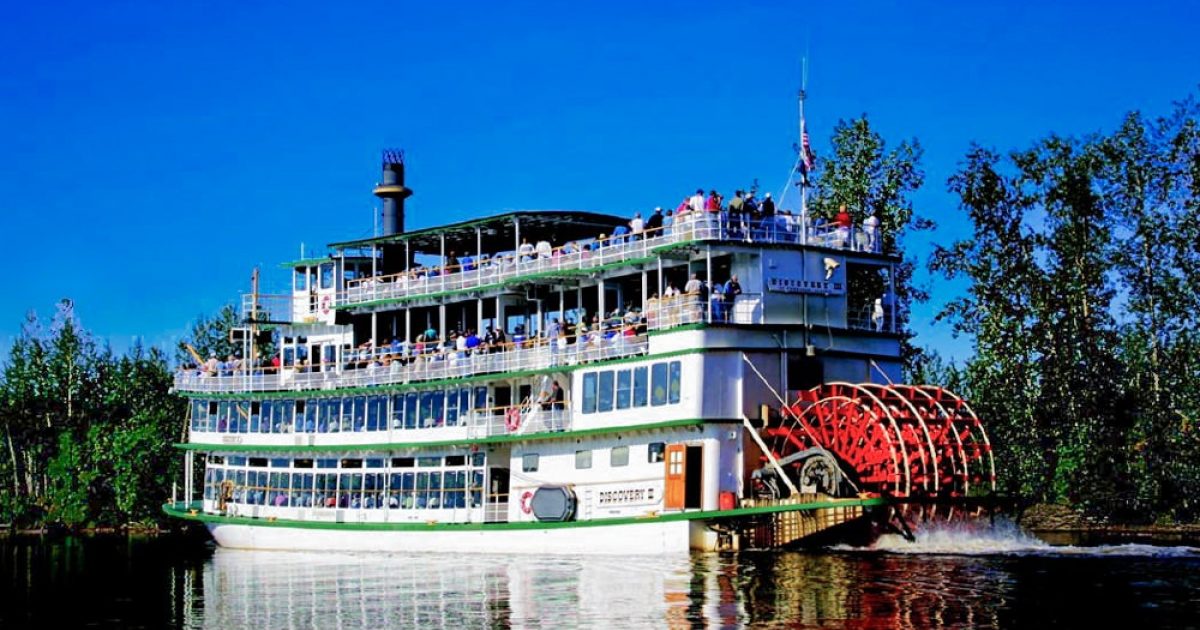
The Humptulips River (left) is a typical alluvial river, while Rush Creek (right) is an example of a non-alluvial river. Both are in Washington State. The second type of river, the "alluvial," is encountered in places less steep, in the bottom of wider valleys, valleys that have flat bottomland (the floodplain) bordering the river.
The river channel contains sediment bars, giving it a braided appearance. For a braided channel to form, there must be plenty of sediments available in the channel to build up bars. Bars can be made of a variety of sediments: silts and sands, gravels, or larger stones. The locations and shapes of sediment bars change over time. Although the ...
Channel geometry and characteristics of stream flow are inherently related. Changes in the geometry of the channel can impact stream velocity and discharge. Figure 18.2.1 18.2. 1: Cross-sectional area. The cross-sectional area of the stream is determined by multiplying channel depth by channel width along a transverse section of the stream.
A wide variety of river and stream channel types exist in limnology, the study of inland waters.All these can be divided into two groups by using the water-flow gradient as either low gradient channels for streams or rivers with less than two percent (2%) flow gradient, or high gradient channels for those with greater than a 2% gradient.
The stream will curve or meander back and forth, forming a deep pool on the outside of each bend, and a gravel or sand bar on the inside of the bend. The channel between bends in the river becomes shallow and turbulent, and is called a riffle. Upstream, the alluvial stream channel is made of gravel.
The river channel itself can be characterized most fundamentally by its cross-section shape and cross-section area. The width is the distance, normal to the local trend of the river, from bank to bank; obviously the width depends strongly on the river stage as well as on the average size of the river.
The deepest part of a river bed is called a channel. The channel is usually located in the middle of a river. Here, the current is often strong. In large rivers, ships travel in channels. Engineers may dredge, or dig, deeper channels so more water can flow through the river or the river can transport larger ships.
Channel pattern is used to describe the plan view of a reach of river as seen from an airplane, and includes meandering, braiding, or relatively straight channels.Natural channels characteristically exhibit alternating pools or deep reaches and riffles or shallow reaches, regardless of the type of pattern. The length of the pool or distance between riffles in a straight channel equals the ...
Channel pattern is used to describe the plan view of a reach of river as seen from an airplane, and includes meandering, braiding, or relatively straight channels.Natural channels characteristically exhibit alternating pools or deep reaches and riffles or shallow reaches, regardless of the type of pattern. The length of the pool or distance between riffles in a straight channel equals the straight
river, (ultimately from Latin ripa, "bank"), any natural stream of water that flows in a channel with defined banks . Modern usage includes rivers that are multichanneled, intermittent, or ephemeral in flow and channels that are practically bankless. The concept of channeled surface flow, however, remains central to the definition. The word stream (derived ultimately from the Indo-European ...
River - Straight Channels, Erosion, Deposition: Straight channels, mainly unstable, develop along the lines of faults and master joints, on steep slopes where rills closely follow the surface gradient, and in some delta outlets. Flume experiments show that straight channels of uniform cross section rapidly develop pool-and-riffle sequences. Pools are spaced at about five bed widths. Lateral ...
Channel (geography) Vivari Channel in Albania links Lake Butrint with the Straits of Corfu. In physical geography and hydrology, a channel is a landform on which a relatively narrow body of water is situated, such as a river, river delta or strait. While channel typically refers to a natural formation, the cognate term canal denotes a similar ...
Abstract. River channel patterns are thought to form a morphological continuum. This continuum is two-dimensional, defined by plan features of which there are three (straight, meandering, branching), and structural levels of fluvial relief of which there are also three (floodplain, flood channel, low-water channel).
The interstitial, water-filled space beneath river beds, where most active aquifer-river water exchange occurs, is termed the hyporheic zone, and is an important habitat for a number of aquatic ...
An understanding of river- and stream-channel geomorphic responses to various human-caused and natural disturbances is important for effective management, conservation, and rehabilitation of rivers and streams to accommodate multiple, often conflicting, needs. Channel changes may have implications for the protection of property and structures, water supply, navigation, and habitat.
Channel pattern. Channel patterns are found in rivers, streams, and other bodies of water that transport water from one place to another. Systems of branching river channels dissect most of the sub-aerial landscape, each in a valley proportioned to its size. Whether formed by chance or necessity, by headward erosion or downslope convergence ...
The River Channel Hudson / North Hudson Community Access Television. 901 4th Street, Hudson WI. 54016 Phone 715-386-0115 ...
Swimmers board the historic Columbia Gorge sternwheeler and are ferried across the channel before anchoring on Washington's shores. Upon a signal, participants leap from the decks into the river waters, commencing a 1.1-mile open water swim toward the Columbia River's south (Oregon) shore.
August 22, 2024. This video shows the dramatic clash of colors as storm runoff turns Puget Sound into a swirling mix of brown and blue, the result of something called "turbidity."
Officials respond to I-74 bridge Friday morning to rescue man from river A Channel Cat Water Taxi was in the area and was able to help bring the man to safety, according to Bettendorf officials ...
Dredging the Columbia River is a complex process needed to keep navigation channels open Subscriber Exclusive U.S. Rep. Marie Gluesenkamp Perez visits dredging vessel to learn about where she can ...
Answer 1 of 6: Hi, I am travelling with my 10 years old son on transiberian train and will make a few stops on the way. I wonder how many days to stop and what to see in Yekaterinburg ? Thanks
Shortly after 8 p.m. on Friday, the Boone County Water Rescue and other agencies responded to the river for a possible body floating down in between the Purple People and Taylor Southgate Bridges.
Fairfield police on Friday said the body of 59-year-old Robert Macisaac was found in the Aspetuck River in Westport on Thursday. ... News Channel 3-12 is committed to providing a forum for civil ...
A riverboat is a watercraft designed for inland navigation on lakes, rivers, and artificial waterways. ... The significance of riverboats is dependent on the number of navigable rivers and channels as well as the condition of the road and rail network. Generally speaking, ...
View the 2024 Florida primary election for House, including live results and maps by county and district.
Fours Rooms Hostel, Yekaterinburg, Russia - Sverdlovsk Oblast: See traveler reviews, 13 candid photos, and great deals for Fours Rooms Hostel, ranked #106 of 172 specialty lodging in Yekaterinburg, Russia - Sverdlovsk Oblast and rated 4 of 5 at Tripadvisor.
A mature channel catfish pulled from a river in Illinois by the Great Rivers Field Station. The popular fish was one of nine species put in focus by the University of Illinois during a study of four northern Illinois rivers. (Photo by Julia Hampton) Scientists from the University of Illinois tested ...
In the ever-changing landscape of Middle Tennessee, trees are disappearing. Root Nashville — a partnership of Metro Nashville and the Cumberland River Compact — is working to change that.
July Hostel, Yekaterinburg, Russia - Sverdlovsk Oblast: See traveler reviews, candid photos, and great deals for July Hostel at Tripadvisor.

IMAGES
VIDEO
COMMENTS
Learn about the types of captain's licenses, their requirements, and how to use them for commercial sailing. Find out why you may not need a license to sail a boat recreationally, but why you should still consider getting one for your education and career.
You need a license to sail a catamaran if you use the vessel for commercial purposes, if your local laws require it, or if you tend to travel often globally. The type of license you'll need to obtain depends on your goals and intentions, as well as the state/country you're living in. Firstly, if you're a commercial sailor, having a ...
In the United States, the U.S. Coast Guard is responsible for regulating recreational boating. The Coast Guard requires that individuals who wish to operate a recreational boat or sail a catamaran must be at least 16 years of age and have a valid boating license. Depending on the state, the license may be referred to as a boating safety ...
Learn about the American Sailing Association's progressive sailing certification programs and endorsements for keelboat, small boat, multihull, and offshore sailing. Find out the knowledge and skills requirements, pre-requisites, and benefits of each certification and endorsement.
NauticEd provides a Catamaran Sailing Certification in two forms. One is a Catamaran Qualification, the other is a Catamaran Endorsement. The difference is that a Catamaran Qualification means a student has passed the online catamaran course and has demonstrated via their logbook sufficient catamaran sailing experience for NauticEd to feel confident that the charter company will allow the ...
Learn whether you need a license to sail a boat in your state and how to get a USCG captain's license for commercial sailing. Find out the differences between sailing certification and sailing license, and the legal implications of sailing without a license.
Learn how to skipper a keelboat on a multi-day cruise in moderate to heavy conditions. Find out the prerequisites, recommendations, standards, and study materials for ASA 104, Bareboat Cruising certification.
Learn how to skipper a sailing cruising catamaran of 30 to 45 feet in moderate to heavy conditions. Find out the prerequisites, study materials, standards and skills for this certification.
Find a school near you Recommended Equipment: The multihull endorsement course and examination shall be conducted on a catamaran of at least 34′, with wheel steering, twin engine auxiliary power, and adequate equipment inventory to complete all required certification outcomes. Prerequisites: The prerequisite for the Catamaran Endorsement is a US Sailing Bareboat Cruising certification. This
The two main captain's licenses issued by the Coast Guard are the Operator of Uninspected Passenger Vessels, also known as the Six-Pack or charter boat captain's license, and the 25, 50, or 100-Ton Master License. The Six-Pack Captain's License allows the holder to carry up to six paying passengers plus crew on uninspected vessels up to ...
For both Catamaran Endorsement and Catamaran Qualification, your SLC License will reflect that you are Catamaran Licensed. Here is an example of the SLC card for either Cat endorsed or Cat Qualified. ... qualifies you to be able to rent a boat that is up to 10 feet greater than the largest size of boat you have sailed 5 times. All charter ...
Learn to cruise on a catamaran! The Cruising Catamaran Certification Course is a four-day sailing class designed to create confident, competent catamaran sailors. You'll spend the first day learning the fundamentals of sailing while aboard a 33-39' monohull. This is the perfect setting to learn terminology, sail trim and boating basics.
Learn to sail or improve your skills with US Sailing, the National Governing Body for the Sport of Sailing. Find a course, a school, and an endorsement that suits your goals and needs.
Learn about the different types of captain's licenses issued by the Coast Guard, such as the Six-Pack and Master licenses, and the endorsements you can add to them. Find out if you need a captain's license for your boat and how to get one online.
Learn online to earn your captain's license using Mariners Learning System. Whether you want to operate charters for fishing or sailing, to provide commercially available guide services, to become a certified instructor, or just to be a safer boater, the Operator of Uninspected Vessels (OUPV/Six-Pack) Captain's License will set you on your way!
Step 5 (Optional) - Catamaran Endorsement: If you complete the online Catamaran course and log large catamaran experience, you will be awarded a valid catamaran endorsement on your SLC document. Step 6 - License Issue: Once all the conditions are met, the license is issued immediately in real-time and ready for immediate download.
Learn the difference between a boat captain and a boat operator, and when you need a captain's license from the USCG. Find out the requirements, costs, and penalties for operating a commercial vessel without a license.
Learn how to sail a catamaran with ASA 114, a course for experienced cruisers who want to master the skills of multihull sailing. You'll need Basic Keelboat, Basic Coastal Cruising, and Bareboat Cruising certificates as prerequisites.
A Teralani Sunset Sail boat ran aground near Whalers Village on Maui Tuesday night. Four people were hospitalized after the incident, which occurred around 7 p.m.
Comment - This license tag is also applicable to official documents, state symbols and signs of the Russian Soviet Federative Socialist Republic and the Union of Soviet Socialist Republics (union level). Warning - This license tag is not applicable to drafts of official documents, proposed official symbols and signs, which can be copyrighted.
Warning - This license tag is not applicable to drafts of official documents, proposed official symbols and signs, which can be copyrighted. Warning - This Russian official document, state symbol or sign (postage stamps, coins and banknotes mainly) may incorporate one or more works that can be copyrightable if separated from this document ...
There are stadiums and arenas that host all three that have fairly cheap tickets. There is an indoor water park and lots of parks and green spaces. The Urals have many lakes, forests and mountains are great for hiking, boating, berry and mushroom hunting, swimming and fishing. Winter sports include cross-country skiing and ice skating.
The IPC (International Proficiency Certificate) is a document American Sailing designed specifically for charter companies in the Mediterranean as proof of bareboat competency in another format other than our official log book. And it's meant mainly for countries who do not accept the UNECE's ICC (International Certificate of Competency) but ...
The Humptulips River (left) is a typical alluvial river, while Rush Creek (right) is an example of a non-alluvial river. Both are in Washington State. The second type of river, the "alluvial," is encountered in places less steep, in the bottom of wider valleys, valleys that have flat bottomland (the floodplain) bordering the river.... The river channel contains sediment bars, giving it a ...